Magmatic Evolution at the Saindak Cu-Au Deposit: Implications for the Formation of Giant Porphyry Deposits
Abstract
1. Introduction
2. Geological Setting
3. Ore Deposit Geology
4. Sampling and Methodology
4.1. Sampling
4.2. Whole-Rock Geochemical Analysis: Major and Trace Elements
4.3. Whole-Rock Sr-Nd Isotopes
4.4. LA-ICP-MS Zircon U-Pb Dating and Hf Isotopes
4.5. Molybdenite Re–Os Dating
5. Results
5.1. Petrology and Ore Mineralogy
5.1.1. Quartz Diorite Porphyry
5.1.2. Diorite Porphyry and MMEs
5.1.3. Mafic Dikes
5.1.4. Ore Mineralogy
- (1)
- Pyrite–Magnetite–Molybdenite–Quartz Stage
- (2)
- Quartz–Chalcopyrite–Pyrite Stage
- (3)
- Sphalerite–Galena–Gypsum Stage
5.2. Geochronology of the Multiple Intrusive Phases
5.3. Molybdenite Re–Os Ages
5.4. Geochemistry of Intrusive Rocks
- (1)
- Whole-Rock Geochemical Signatures: Major and Trace Constituents
- (2)
- Bulk-Rock Sr-Nd Isotopes
5.5. Lu-Hf Isotope Compositions of Zircons
6. Discussion
6.1. Mineralization Stage Division and Alteration Process
6.2. Magmatism and Mineralization Age
6.3. Magma Source, Petrogenesis and Geodynamic Setting
6.3.1. Magma Source of Ore-Bearing Quartz Diorite Porphyry

6.3.2. Magma Source of Diorite Porphyry and Mafic Dikes
6.3.3. Petrogenesis of Multiple Intrusions
6.3.4. Geodynamic Setting
6.4. Genetic Model for the Saindak Cu-Au Deposit
6.5. Insights into the Formation of Giant Porphyry Deposits
7. Conclusions
- (1)
- LA-ICP-MS zircon U–Pb dating results demonstrate that quartz diorite porphyry, diorite porphyry, and mafic dikes from the Saindak porphyry copper–gold deposit were emplaced during the Miocene (~22 Ma). Molybdenite Re-Os ages indicate that the quartz diorite porphyries are both chronologically and spatially related to the Saindak copper–gold mineralization. U–Pb and Re–Os geochronology confirms that both ore-bearing and barren porphyries, as well as associated mafic dikes and MMEs, are closely coeval, with emplacement ages centered around 22~21 Ma. This suggests a short-lived but dynamic magmatic episode during porphyry formation.
- (2)
- Porphyry-related magmas are typically related to the medium–K calc-alkaline series, exhibiting evolved compositions and adakitic affinities. They are characterized by hornblende and biotite phenocrysts, indicative of high magmatic water content. They have relatively high Sr/Y and La/Yb ratios and a lack of negative Eu anomalies, reflecting a mature arc setting.
- (3)
- Rather than a continental collision, the subduction of the Arabian oceanic plate below the Eurasian plate produced the Saindak porphyry copper deposit. Geochemical signatures and isotopic compositions indicate that the Saindak adakitic magmas were primarily derived from the partial melting of a metasomatized mantle wedge and influenced by slab-derived fluids and minor sediment contributions and subsequent crust–mantle interactions during magma ascent.
- (4)
- It is proposed that a mature Andean-type continental margin arc, characterized by prolonged arc magmatism and shallow subduction of the remnant oceanic crust, was critical to the formation of the giant porphyry copper deposits in the Chagai belt.
Supplementary Materials
Author Contributions
Funding
Data Availability Statement
Acknowledgments
Conflicts of Interest
References
- Richards, J.P. Tectono-magmatic precursors for porphyry Cu-(Mo-Au) deposit formation. Econ. Geol. 2003, 98, 1515–1533. [Google Scholar] [CrossRef]
- Richards, J.P. High Sr/Y arc magmas and porphyry Cu ± Mo ± Au deposits: Just add water. Econ. Geol. 2011, 106, 1075–1081. [Google Scholar] [CrossRef]
- Cooke, D.R.; Hollings, P.; Walshe, J.L. Giant Porphyry Deposits: Characteristics, Distribution, and Tectonic Controls. Econ. Geol. 2005, 100, 801–818. [Google Scholar] [CrossRef]
- Cooke, D.R.; Deyell, C.L.; Waters, P.J.; Gonzales, R.I.; Zaw, K. Evidence for magmatic–hydrothermal fluids and ore–forming processes in epithermal and porphyry deposits of the Baguio District, Philippines. Econ. Geol. 2011, 106, 1399–1424. [Google Scholar] [CrossRef]
- Sillitoe, R.H. Porphyry copper systems. Econ. Geol. 2010, 105, 3–41. [Google Scholar] [CrossRef]
- Shafiei, B.; Haschke, M.; Shahabpour, J. Recycling of orogenic arc crust triggers porphyry Cu mineralization in Kerman Cenozoic arc rocks, southeastern Iran. Miner. Depos. 2009, 44, 265–283. [Google Scholar] [CrossRef]
- Hou, Z.Q.; Yang, Z.M.; Qu, X.M.; Meng, X.J.; Li, Z.Q.; Beaudoin, G.; Rui, Z.Y.; Gao, Y.F.; Zaw, K. The Miocene Gangdese porphyry copper belt generated during post-collisional extension in the Tibetan Orogen. Ore Geol. Rev. 2009, 36, 25–51. [Google Scholar] [CrossRef]
- Yang, J.S.; Shi, R.D.; Wu, C.L.; Wang, X.B.; Robinson, P.T. Dur’ngoi ophiolite in East Kunlun, northeast Tibetan Plateau: Evidence for Paleo-Tethyan suture in northwest China. J. Earth Sci. 2009, 20, 303–331. [Google Scholar] [CrossRef]
- Yang, Z.M.; Hou, Z.Q.; Xu, J.F.; Bian, X.F.; Wang, G.R.; Yang, Z.S.; Tian, S.H.; Liu, Y.C.; Wang, Z.L. Geology and origin of the post-collisional Narigongma porphyry Cu–Mo deposit, southern Qinghai, Tibet. Gondwana Res. 2014, 26, 536–556. [Google Scholar] [CrossRef]
- Hou, Z.Q.; Gao, Y.F.; Qu, X.M.; Rui, Z.Y.; Mo, X.X. Origin of adakitic intrusives generated during mid-Miocene east–west extension in southern Tibet. Earth Planet. Sci. Lett. 2004, 220, 139–155. [Google Scholar] [CrossRef]
- Hou, Z.Q.; Zheng, Y.C.; Yang, Z.M.; Rui, Z.Y.; Zhao, Z.D.; Jiang, S.Y.; Qu, X.M.; Sun, Q.Z. Contribution of mantle components within juvenile lower crust to collisional zone porphyry Cu systems in Tibet. Miner. Depos. 2013, 48, 173–192. [Google Scholar] [CrossRef]
- Hou, Z.Q.; Yang, Z.M.; Lu, Y.J.; Kemp, A.; Zheng, Y.C.; Li, Q.Y.; Tang, J.X.; Yang, Z.S.; Duan, L.F. A genetic linkage between subduction- and collision-related porphyry Cu deposits in continental collision zones. Geology 2015, 43, 247–250. [Google Scholar] [CrossRef]
- Razique, A.; Tosdal, R.M.; Creaser, R.A. Temporal evolution of the western porphyry Cu–Au systems at Reko Diq, Balochistan, western Pakistan. Econ. Geol. 2014, 109, 2003–2021. [Google Scholar] [CrossRef]
- Deng, J.; Wang, Q.F.; Li, G.; Santosh, M. Cenozoic tectono–magmatic and metallogenic processes in the Sanjiang region, southwestern China. Earth–Sci. Rev. 2014, 138, 268–299. [Google Scholar] [CrossRef]
- Richards, J.P. Tectonic, magmatic, and metallogenic evolution of the Tethyan orogen: From subduction to collision. Ore Geol. Rev. 2015, 70, 323–345. [Google Scholar] [CrossRef]
- Deng, J.; Wang, Q. Gold mineralization in China: Metallogenic provinces, deposit types and tectonic framework. Gondwana Res. 2016, 36, 219–274. [Google Scholar] [CrossRef]
- Sillitoe, R.H.; Khan, S.N. Geology of Saindak porphyry copper deposit, Pakistan. Trans. Inst. Min. Metall. 1977, 86, B27–B42. [Google Scholar]
- Hildreth, W.; Moorbath, S. Crustal contributions to arc magmatism in the Andes of central Chile. Contrib. Mineral. Petrol. 1988, 98, 455–489. [Google Scholar] [CrossRef]
- Seedorff, E.; Dilles, J.H.; Proffett, J.M., Jr.; Einaudi, M.T.; Zurcher, L.; Stavast, W.J.A.; Johnson, D.A.; Barton, M.D. Porphyry deposits: Characteristics and origin of hypogene features. Econ. Geol. 2005, 100, 251–298. [Google Scholar] [CrossRef]
- Yang, Z.M.; Lu, Y.J.; Hou, Z.Q.; Chang, Z.S. High-Mg diorite from Qulong in southern Tibet: Implications for the genesis of adakite-like intrusions and associated porphyry Cu deposits in collisional orogens. J. Petrol. 2015, 56, 227–254. [Google Scholar] [CrossRef]
- Richards, J.P.; Şengör, A.M.C. Did Paleo-Tethyan anoxia kill arc magma fertility for porphyry copper formation? Geology 2017, 45, 591–594. [Google Scholar] [CrossRef]
- Perelló, J.; Razique, A.; Schloderer, J.; Rehman, A.U. The Chagai porphyry copper belt, Baluchistan province, Pakistan. Econ. Geol. 2008, 103, 1583–1612. [Google Scholar] [CrossRef]
- Doebrich, J.L.; Ludington, S.; Peters, S.G.; Finn, C.A.; Mars, J.C.; Rowan, L.C.; Stoeser, D.B.; King, T.M.; Eppinger, R.G.; Wasy, A.; et al. Porphyry copper potential of Tethyan magmatic arcs of Afghanistan. Ir. Assoc. Econ. Geol. 2007, 1, 129–132. [Google Scholar]
- Sillitoe, R.H. Metallogenic evolution of a collisional mountain belt in Pakistan: A preliminary analysis. J. Geol. Soc. Lond. 1978, 135, 377–387. [Google Scholar] [CrossRef]
- Sholeh, A.; Rastad, E.; Huston, D.; Gemmell, J.B.; Taylor, R.D. The Chahnaly low-sulfidation epithermal gold deposit, Western Makran volcanic arc, southeast Iran. Econ. Geol. 2016, 111, 619–639. [Google Scholar] [CrossRef]
- Wang, L.; Zheng, Y.; Hou, Z.; Xue, C.; Yang, Z.; Shen, Y.; Li, X.; Ghaffar, A. The subduction-related Saindak porphyry Cu–Au deposit formed by remelting of a thickened juvenile lower crust underneath the Chagai belt, Pakistan. Ore Geol. Rev. 2022, 149, 105062. [Google Scholar] [CrossRef]
- Hou, Z.Q.; Zhang, H.R.; Pan, X.F.; Yang, Z.M. Porphyry Cu (–Mo–Au) deposits related to melting of thickened mafic lower crust: Examples from the eastern Tethyan metallogenic domain. Ore Geol. Rev. 2011, 39, 21–45. [Google Scholar] [CrossRef]
- Razique, A. Magmatic Evolution and Genesis of the Giant Reko Diq H14–H15 Porphyry Copper–Gold Deposit, District Chagai, Balochistan–Pakistan. Ph.D. Thesis, University of British Columbia, Kelowna, BC, Canada, 2013. [Google Scholar]
- Richards, J.P.; Spell, T.; Rameh, E.; Razique, A.; Fletcher, T. High Sr/Y Magmas Reflect Arc Maturity, High Magmatic Water Content, and Porphyry Cu ± Mo ± Au Potential: Examples from the Tethyan Arcs of Central and Eastern Iran and Western Pakistan. Econ. Geol. 2012, 107, 295–332. [Google Scholar] [CrossRef]
- Siddiqui, R.H.; Jan, M.Q.; Khan, M.A.; Kakar, M.I.; Foden, J.D. Petrogenesis of the Late Cretaceous tholeiitic volcanism and oceanic island arc affinity of the Chagai Arc, western Pakistan. Acta Geol. Sin. 2017, 91, 1248–1263. (In English) [Google Scholar] [CrossRef]
- Lawrence, R.D.; Khan, S.H.; DeJong, K.A.; Farah, A.; Yeats, R.S. Thrust and strike-slip fault interaction along the Chaman transform zone, Pakistan. Geol. Soc. Lond. Spéc. Publ. 1981, 9, 363–370. [Google Scholar] [CrossRef]
- Siddiqui, R.H.; Jan, M.Q.; Khan, M.A. Petrogenesis of Late Cretaceous lava flows from a Ceno-Tethyan island arc: The Raskoh arc, Balochistan, Pakistan. J. Asian Earth Sci. 2012, 59, 24–38. [Google Scholar] [CrossRef]
- Hunting Survey Corporation. Geological survey of Pakistan: Reconnaissance geology of part of Chagai District, West Pakistan. Geol. Surv. Pak. Mem. 1960, 1, 1–80. [Google Scholar]
- Breitzman, L.L. Fission-Track Ages of Intrusives of the Chagai District, Baluchistan, Pakistan. Master’s Thesis, Dartmouth College, Hanover, NH, USA, 1979. [Google Scholar]
- Breitzman, L.L.; Birnie, R.W.; Johnson, G.D. Fission-track ages of the Chagai intrusives, Baluchistan, Pakistan. Geol. Soc. Am. Bull. 1983, 94, 253–258. [Google Scholar] [CrossRef]
- Razique, A.; Tosdal, R.; Bouzari, F. Anatomical similarities and differences between spatially associated porphyry copper–gold deposits at the Reko Diq H14 and H15 complex, Balochistan, Pakistan. Soc. Econ. Geol. Spec. Publ. 2016, 19, 259–278. [Google Scholar]
- Ghaffar, A. Genetic Model of the Superlarge Saindak Porphyry Cu–Au Deposits at Western Chagai Arc in Balochistan Province, Pakistan. Ph.D. Thesis, Kunming University of Science and Technology, Yunnan, China, 2018. [Google Scholar]
- Hong, J.; Ji, W.H.; Yang, X.Y.; Tahseenullah, K.; Wang, R.; Li, W.Y.; Zhang, H.S. Origin of a Miocene alkaline–carbonatite complex in the Dunkeldik area of Pamir, Tajikistan: Petrology, geochemistry, LA–ICP–MS zircon U–Pb dating, and Hf isotope analysis. Ore Geol. Rev. 2019, 107, 820–837. [Google Scholar] [CrossRef]
- Tanaka, T.; Togashi, S.; Kamioka, H.; Amakawa, H.; Kagami, H.; Hamamoto, T.; Yuhara, M.; Orihashi, Y.; Yoneda, S.; Shimizu, H.; et al. JNdi-1: A neodymium isotopic reference in consistency with La Jolla neodymium. Chem. Geol. 2000, 168, 279–281. [Google Scholar] [CrossRef]
- Todt, W.; Cliff, R.A.; Hanser, A.; Hofmann, A.W. Evaluation of a 202Pb–205Pb double spike for high precision lead isotope analysis. In Earth Processes: Reading the Isotopic Code; Basu, A., Hart, S., Eds.; American Geophysical Union Geophysical Monograph: Florida Avenue, WA, USA, 1996; pp. 429–437. [Google Scholar]
- Horn, I.; Rudnick, R.L.; McDonough, W.F. Precise elemental and isotope ratio determination by simultaneous solution nebulization and laser ablation–ICPMS: A new approach for the analysis of geologic materials. Chem. Geol. 2000, 164, 281–301. [Google Scholar] [CrossRef]
- Ballard, J.R.; Palin, J.M.; Williams, I.S.; Campbell, I.H. Two ages of porphyry intrusions resolved for the super-giant Chuquicamata copper deposit of northern Chile by ELA-ICP-MS and SHRIMP. Geology 2001, 29, 383–386. [Google Scholar] [CrossRef]
- Yuan, H.L.; Gao, S.; Liu, X.M.; Li, H.M.; Günther, D.; Wu, F.Y.; Zhou, L. Accurate U–Pb age and trace element determinations of zircon by laser ablation–inductively coupled plasma–mass spectrometry. Geostand. Geoanalytical Res. 2004, 28, 353–370. [Google Scholar] [CrossRef]
- Liu, Y.; Gao, S.; Hu, Z.; Gao, C.; Zong, K.; Wang, D. Continental and oceanic crust recycling-induced melt-peridotite interactions in the Trans-North China Orogen: U–Pb dating, Hf isotopes and trace elements in zircons from mantle xenoliths. J. Petrol. 2010, 51, 537–571. [Google Scholar] [CrossRef]
- Ludwig, K.R. Isoplot/Ex 3.23: A geochronological toolkit for Microsoft Excel. Berkeley Geochronol. Cent. Spec. 2003, 4, 73. [Google Scholar]
- Cui, Y.R.; Xiao, Z.B.; Tu, J.R.; Zhou, H.Y.; Li, G.Z. Research Progress in situ Hf Isotopic Analysis of Oxide-type U-bearing Accessory Minerals. Rock Miner. Anal. 2022, 41, 691–703. [Google Scholar] [CrossRef]
- Yuan, H.L.; Gao, S.; Dai, M.N.; Zong, C.L.; Günther, D.; Fontaine, G.H.; Liu, X.M.; Diwu, C.R. Simultaneous determinations of U–Pb age, Hf isotopes and trace element compositions of zircon by excimer laser-ablation quadrupole and multiple-collector ICP-MS. Chem. Geol. 2008, 247, 100–118. [Google Scholar] [CrossRef]
- DeBievre, P.; Taylor, P.D.P. Table of the isotopic compositions of the elements. Int. J. Mass Spectrom. Ion Process. 1993, 123, 149–166. [Google Scholar] [CrossRef]
- Chu, N.; Taylor, R.N.; Chavagnac, V.; Nesbitt, R.W.; Boella, R.; Milton, J.A.; German, C.R.; Bayon, G.; Burton, K.W. Hf isotope ratio analysis using multi-collector inductively coupled plasma mass spectrometry: An evaluation of isobaric interference corrections. J. Anal. At. Spectrom. 2002, 17, 1567–1574. [Google Scholar] [CrossRef]
- Griffin, W.L.; Pearson, N.J.; Belousova, E.A.; O’Reilly, S.Y. Comment: Hf isotopes in zircon and the formation of continental crust. Chem. Geol. 2006, 233, 358–363. [Google Scholar] [CrossRef]
- Griffin, W.L.; Pearson, N.J.; Belousova, E.; Jackson, S.E.; van Achterbergh, E.; O’Reilly, S.Y.; Shee, S.R. The Hf isotope composition of cratonic mantle: LAM–MC–ICPMS analysis of zircon megacrysts in kimberlites. Geochim. Cosmochim. Acta 2000, 64, 133–147. [Google Scholar] [CrossRef]
- Vervoort, J.D.; Blichert-Toft, J. Evolution of the depleted mantle: Hf isotope evidence from juvenile rocks through time. Geochim. Cosmochim. Acta 1999, 63, 533–556. [Google Scholar] [CrossRef]
- Scherer, E.E.; Münker, C.; Mezger, K. Calibration of the lutetium–hafnium clock. Science 2001, 293, 683–687. [Google Scholar] [CrossRef] [PubMed]
- Li, X.W.; Li, C.; Zhou, L.M.; Zhao, H.; Qu, W.J. A Review of Research Progress on Re-Os Isotopic System of Carbon-enriched Geological Samples. Rock Miner. Anal. 2023, 42, 221–238. [Google Scholar] [CrossRef]
- Shirey, S.B.; Walker, R.J. Carius tube digestion for low-blank rhenium–osmium analysis. Anal. Chem. 1995, 67, 2136–2141. [Google Scholar] [CrossRef]
- Mao, J.W.; Zhang, Z.C.; Zhang, Z.H.; Du, A.D. Re–Os isotopic dating of molybdenites in the Xiaoliugou W (Mo) deposit in the northern Qilian mountains and its geological significance. Geochim. Cosmochim. Acta 1999, 63, 1815–1818. [Google Scholar]
- Smoliar, M.I.; Walker, R.J.; Morgan, J.W. Re–Os ages of group IIA, IIIA, IVA, and IVB iron meteorites. Science 1996, 271, 1099–1102. [Google Scholar] [CrossRef]
- Ludwig, K.R. ISOPLOT/Ex version 2.49: A geochronological toolkit for Microsoft Excel. Berkeley Geochronol. Cent. Spec. Publ. 1999, 55, 10011476874. [Google Scholar]
- Wiebe, R.A.; Blair, K.; Hawkins, D.P.; Sabine, C.P. Mafic injections, magma mixing, and the formation of dioritic enclaves in granitic rocks of the Cadillac Mountain intrusive complex, Maine. J. Petrol. 2002, 43, 2027–2048. [Google Scholar]
- Mastoi, A.S.; Yang, X.; Deng, J.; Kashani, A.G.; Hakro, A.A.D. Geochronological and geochemical studies of adakites from Tethyan Belt, Western Pakistan: A clue to geodynamics and Cu–Au mineralization. Int. Geol. Rev. 2019, 62, 1273–1293. [Google Scholar] [CrossRef]
- Sun, S.S.; McDonough, W.F. Chemical and isotopic systematics of oceanic basalts: Implications for mantle composition and processes. Geol. Soc. Lond. Spec. Publ. 1989, 42, 313–345. [Google Scholar] [CrossRef]
- Griffin, W.L.; Wang, X.; Jackson, S.E.; Pearson, N.J.; O’Reilly, S.Y.; Xu, X.S.; Zhou, X.M. Zircon chemistry and magma mixing, SE China: In–situ analysis of Hf isotopes, Tonglu and Pingtan igneous complexes. Lithos 2002, 61, 237–269. [Google Scholar] [CrossRef]
- Belousova, E.; Griffin, W.; O’Reilly, S.; Fisher, N. Igneous zircon: Trace element composition as an indicator of source rock type. Contrib. Mineral. Petrol. 2002, 143, 602–622. [Google Scholar] [CrossRef]
- Hoskin, P.W.O.; Schaltegger, U. The composition of zircon and igneous and metamorphic petrogenesis. Rev. Mineral. Geochem. 2003, 53, 27–62. [Google Scholar] [CrossRef]
- Hintenberger, H.; Herr, W.; Voshage, H. Radiogenic osmium from rhenium-containing molybdenite. Phys. Rev. 1954, 95, 1690–1691. [Google Scholar] [CrossRef]
- Shirey, S.B.; Walker, R.J. The Re–Os isotope system in cosmochemistry and high-temperature geochemistry. Annu. Rev. Earth Planet. Sci. 1998, 26, 423–500. [Google Scholar] [CrossRef]
- Mirnejad, H.; Mathur, R.; Hassanzadeh, J.; Shafie, B.; Nourali, S. Linking Cu mineralization to host porphyry emplacement: Re–Os ages of molybdenites versus U–Pb ages of zircons and sulfur isotope compositions of pyrite and chalcopyrite from the Iju and Sarkuh porphyry deposits in southeast Iran. Econ. Geol. 2013, 108, 861–870. [Google Scholar] [CrossRef]
- Richards, J.P.; Razavi, A.M.; Spell, T.L.; Locock, A.; Sholeh, A.; Aghazadeh, M. Magmatic evolution and porphyry–epithermal mineralization in the Taftan volcanic complex, southeastern Iran. Ore Geol. Rev. 2018, 95, 258–279. [Google Scholar] [CrossRef]
- Zheng, Y.C.; Wu, C.D.; Tian, S.H.; Hou, Z.Q.; Fu, Q.; Zhu, D.C. Magmatic and structural controls on the tonnage and metal associations of collision-related porphyry copper deposits in southern Tibet. Ore Geol. Rev. 2020, 122, 103509. [Google Scholar] [CrossRef]
- Martin, H.; Smithies, R.H.; Rapp, R.; Moyen, J.F.; Champion, D. An overview of adakite, tonalite–trondhjemite–granodiorite (TTG), and sanukitoid: Relationships and some implications for crustal evolution. Lithos 2005, 79, 1–24. [Google Scholar] [CrossRef]
- Moyen, J.F. High Sr/Y and La/Yb ratios: The meaning of the “adakitic signature”. Lithos 2009, 112, 556–574. [Google Scholar] [CrossRef]
- Rapp, R.P.; Watson, E.B. Dehydration melting of metabasalt at 8–32 kbar: Implications for continental growth and crust–mantle recycling. J. Petrol. 1995, 36, 891–931. [Google Scholar] [CrossRef]
- Defant, M.J.; Drummond, M.S. Derivation of some modern arc magmas by melting of young subducted lithosphere. Nature 1990, 347, 662–665. [Google Scholar] [CrossRef]
- Rapp, R.P.; Shimizu, N.; Norman, M.D.; Applegate, G.S. Reaction between slab-derived melts and peridotite in the mantle wedge: Experimental constraints at 3.8 GPa. Chem. Geol. 1999, 160, 335–356. [Google Scholar] [CrossRef]
- Zhu, D.C.; Zhao, Z.D.; Pan, G.T.; Lee, H.Y.; Kang, Z.Q.; Liao, Z.L.; Wang, L.Q.; Li, G.M.; Dong, G.C.; Liu, B. Early Cretaceous subduction-related adakite-like rocks of the Gangdese Belt, southern Tibet: Products of slab melting and subsequent melt–peridotite interaction? J. Asian Earth Sci. 2009, 34, 298–309. [Google Scholar] [CrossRef]
- Wu, C.D.; Zheng, Y.C.; Xu, B.; Hou, Z.Q. The genetic relationship between JTA-like magmas and typical adakites: An example from the Late Cretaceous Nuri complex, southern Tibet. Lithos 2018, 320–321, 265–279. [Google Scholar] [CrossRef]
- Kemp, A.I.S.; Hawkesworth, C.J.; Paterson, B.A.; Kinny, P.D. Episodic growth of the Gondwana continental crust: New SHRIMP zircon U–Pb and Hf isotope data from the Lachlan Fold Belt, southeastern Australia. Earth Planet. Sci. Lett. 2007, 251, 303–326. [Google Scholar] [CrossRef]
- Xu, Y.G.; Zhang, H.H.; Zou, H.B. Geochemistry of continental basalts and mantle xenoliths. In Petrology and Geochemistry of Continental Volcanic Rocks in Eastern China; Tang, D.H., Ed.; Geological Publishing House: Beijing, China, 2012. [Google Scholar]
- Feeley, T.C.; Cosca, M.A.; Lindsay, C.R. Petrogenesis and implications of calc-alkaline cryptic hybrid magmas from Washburn volcano, Absaroka Volcanic Province, USA. J. Petrol. 2002, 43, 663–703. [Google Scholar] [CrossRef]
- McDonough, W.F.; Sun, S.S. The Composition of the Earth. Chem. Geol. 1995, 120, 223–253. [Google Scholar] [CrossRef]
- Hawkesworth, C.J.; Gallagher, K.; Hergt, J.M.; McDermott, F. Mantle and slab contributions in arc magmas. Annu. Rev. Earth Planet. Sci. 1993, 21, 175–204. [Google Scholar] [CrossRef]
- Rudnick, R.L.; Gao, S. Composition of the Continental Crust. In Treatise on Geochemistry; Holland, H.D., Turekian, K.K., Eds.; Elsevier: Oxford, UK, 2003; pp. 1–64. [Google Scholar]
- Castillo, P.R. Adakite petrogenesis. Lithos 2012, 134–135, 304–316. [Google Scholar] [CrossRef]
- Richards, J.P.; Kerrich, R. Adakite-like rocks: Their diverse origins and questionable role in metallogenesis. Econ. Geol. 2007, 102, 537–576. [Google Scholar] [CrossRef]
- Siddiqui, R.H. Magmatic evolution of Chagai–Raskoh arc terrane and its implication for porphyry copper mineralization. Geologica 1996, 2, 87–119. [Google Scholar]
- Yang, Z.M.; Goldfarb, R.; Chang, Z.S. Generation of postcollisional porphyry copper deposits in southern Tibet triggered by subduction of the Indian continental plate. Soc. Econ. Geol. Spec. Publ. 2016, 19, 279–300. [Google Scholar]
- Jolivet, L.; Faccenna, C. Mediterranean extension and the Africa–Eurasia collision. Tectonics 2000, 19, 1095–1106. [Google Scholar] [CrossRef]
- McQuarrie, N.; Stock, J.M.; Verdel, C.; Wernicke, B.P. Cenozoic evolution of Neotethys and implications for the causes of plate motions. Geophys. Res. Lett. 2003, 30, 2036. [Google Scholar] [CrossRef]
- Homke, S.; Vergés, J.; Garcés, M.; Emami, H.; Karpuz, R. Magnetostratigraphy of Miocene–Pliocene Zagros foreland deposits in the front of the Push-e-Kush Arc (Lurestan Province, Iran). Earth Planet. Sci. Lett. 2004, 225, 397–410. [Google Scholar] [CrossRef]
- Molinaro, M.; Leturmy, P.; Guezou, J.C.; Frizon de Lamotte, D.; Eshraghi, S.A. The structure and kinematics of the southeastern Zagros fold-thrust belt, Iran: From thin-skinned tectonics. Tectonics 2005, 24, TC3007. [Google Scholar] [CrossRef]
- Pang, K.N.; Chung, S.L.; Zarrinkoub, M.H.; Chiu, H.Y.; Li, X.H. On the magmatic record of the Makran arc, southeastern Iran: Insights from zircon U–Pb geochronology and bulk-rock geochemistry. Geochem. Geophys. Geosystems 2014, 15, 2151–2169. [Google Scholar] [CrossRef]
- Khan, M.A.; Siddiqui, R.H.; Jan, M.Q. Temporal Evolution of Cretaceous to Pleistocene Magmatism in the Chagai Arc, Balochistan, Pakistan; Open-File Report 2010–1099; U.S. Geological Survey: Reston, VA, USA, 2010.
- Nicholson, K.N.; Khan, M.; Mahmood, K. Geochemistry of the Chagai–Raskoh arc, Pakistan: Complex arc dynamics spanning the Cretaceous to the Quaternary. Lithos 2010, 118, 338–348. [Google Scholar] [CrossRef]
- Zürcher, L.; Bookstrom, A.A.; Hammarstrom, J.M.; Mars, J.C.; Ludington, S.D.; Zientek, M.L.; Dunlap, P.; Wallis, J.C. Tectono–magmatic evolution of porphyry belts in the central Tethys region of Turkey, the Caucasus, Iran, western Pakistan, and southern Afghanistan. Ore Geol. Rev. 2019, 111, 1–74. [Google Scholar] [CrossRef]
- Wong, J.; Sun, M.; Xing, G.; Li, X.; Zhao, G.; Wong, K.; Yuan, C.; Xia, X.; Li, L.; Wu, F. Geochemical and zircon U–Pb and Hf isotopic study of the Baijuhuajian metaluminous A-type granite: Extension at 125–100 Ma and its tectonic significance for South China. Lithos 2009, 112, 289–305. [Google Scholar] [CrossRef]
- Gutscher, M.A.; Maury, R.; Eissen, J.P.; Bourdon, E. Can slab melting be caused by flat subduction? Geology 2000, 28, 535–538. [Google Scholar] [CrossRef]
- Abratis, M.; Wörner, G. Ridge collision slab-window formation and the flux of Pacific asthenosphere into the Caribbean realm. Geology 2001, 29, 127–130. [Google Scholar] [CrossRef]
- Ling, M.X.; Wang, F.Y.; Ding, X.; Hu, Y.H.; Zhou, J.B.; Zartman, R.E.; Yang, X.Y.; Sun, W.D. Cretaceous ridge subduction along the lower Yangtze River Belt, Eastern China. Econ. Geol. 2009, 104, 303–321. [Google Scholar] [CrossRef]
- Yogodzinski, G.M.; Lees, J.M.; Churikova, T.G.; Dorendorf, F.; Woerner, G.; Volynets, O.N. Geochemical evidence for the melting of subducting oceanic lithosphere at plate edges. Nature 2001, 409, 500–504. [Google Scholar] [CrossRef] [PubMed]
- Sillitoe, R.H. A plate tectonic model for the origin of porphyry copper deposits. Econ. Geol. 1972, 67, 184–197. [Google Scholar] [CrossRef]
- Hollings, P.; Cook, D.; Clark, A. Regional geochemistry of Tertiary igneous rocks in Central Chile: Implications for the geodynamic environment of giant porphyry copper and epithermal gold mineralization. Econ. Geol. 2005, 100, 887–904. [Google Scholar] [CrossRef]
- Tosdal, R.M.; Dilles, J.H.; Cook, D.R. From source to sinks in auriferous magmatic hydrothermal porphyry and epithermal deposits. Elements 2009, 5, 289–295. [Google Scholar] [CrossRef]
- Stern, R.J. Subduction zones. Rev. Geophys. 2002, 40, 3-1–3-38. [Google Scholar] [CrossRef]
- Rubinstein, N.A.; Zappettini, E.O.; Gómez, A.L.R. Porphyry CU deposits in the Central Andes of Argentina: An overview. J. S. Am. Earth Sci. 2021, 112, 103543. [Google Scholar] [CrossRef]
- Audétat, A.; Günther, D.; Heinrich, C.A. Magmatic-hydrothermal evolution in a porphyry copper system: A case study from the Bingham Canyon deposit, Utah. Geochim. Cosmochim. Acta 2008, 72, 139–168. [Google Scholar]
- Hong, J.; Zhang, H.S.; LV, P.R.; Tahseenullah, K.; Yasir, S.K.; Wang, Z.H.; Zhang, H.D. Tectono–magmatic evolution of the Neo-Tethys belt in Pakistan and related mineralization of major metal mineral meposits. Northwestern Geol. 2024, 57, 1–23, (In Chinese with English Abstrct). [Google Scholar] [CrossRef]
- Wang, X.; Li, W.; Romer, R.L.; Yang, F.; Li, J.; Liu, K.; Zhang, Z.; Yan, L. Genesis and geodynamic setting of granitoids at the giant Siah Diq S1 porphyry Cu Au deposit, Chagai belt, Western Pakistan. Lithos 2025, 494–495, 107919. [Google Scholar] [CrossRef]
- Khalil, Y.S.; Wenyuan, L.; Huang, J.; Abbas, S.A.; Jun, H. Geophysical exploration and geological appraisal of the Siah Diq porphyry Cu–Au prospect: A recent discovery in the Chagai volcano magmatic arc, SW Pakistan. Open Geosci. 2022, 14, 1250–1267. [Google Scholar] [CrossRef]
- Siddiqui, R.H.; Khan, M.A.; Jan, M.Q.; Kakar, M.I.; Kerr, A.C. Geochemistry and petrogenesis of Oligocene volcaniclastic rocks from the Chagai arc: Implications for the emplacement of porphyry copper deposits. Arab. J. Geosci. 2015, 8, 8655–8667. [Google Scholar] [CrossRef]
- Dorais, M.J.; Whitney, J.A.; Peterman, Z.E. Origin of biotite-apatite-rich enclaves, Lamarck Granodiorite, Sierra Nevada, California. J. Petrol. 1990, 31, 763–797. [Google Scholar]
- Barbarin, B. Mafic microgranular enclaves and mafic rocks associated with some granitoids of the central Sierra Nevada batholith, California: Nature, origin and relations with the hosts. Lithos 2005, 80, 155–177. [Google Scholar] [CrossRef]
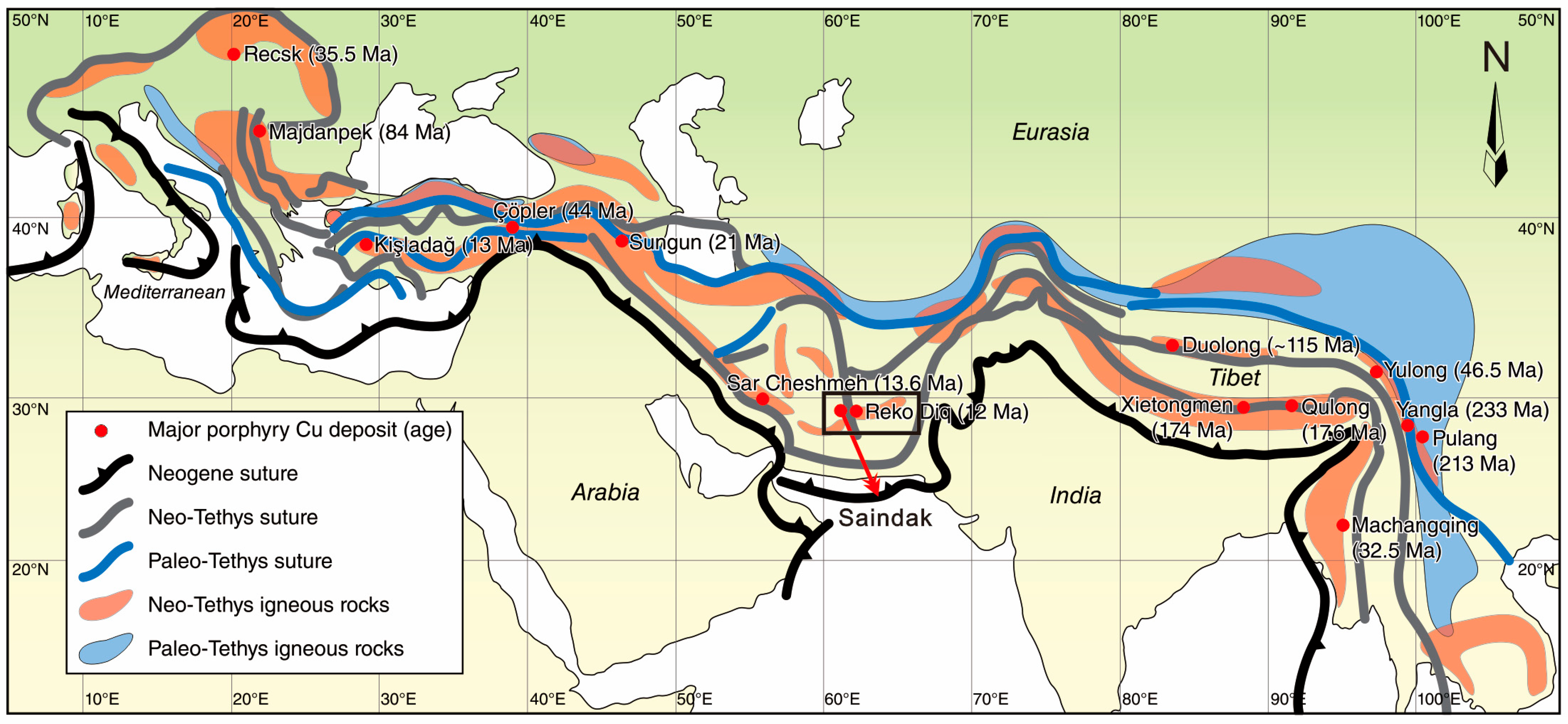
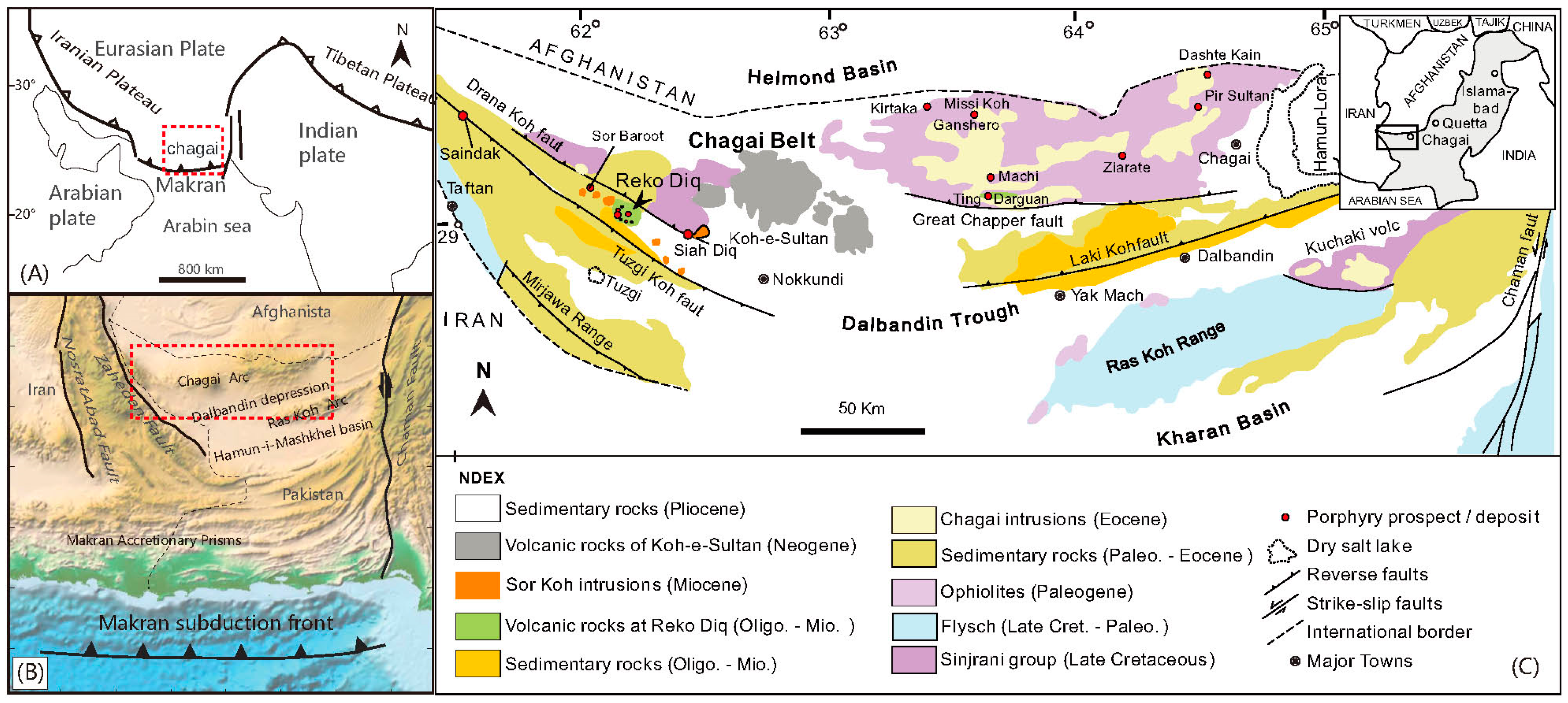

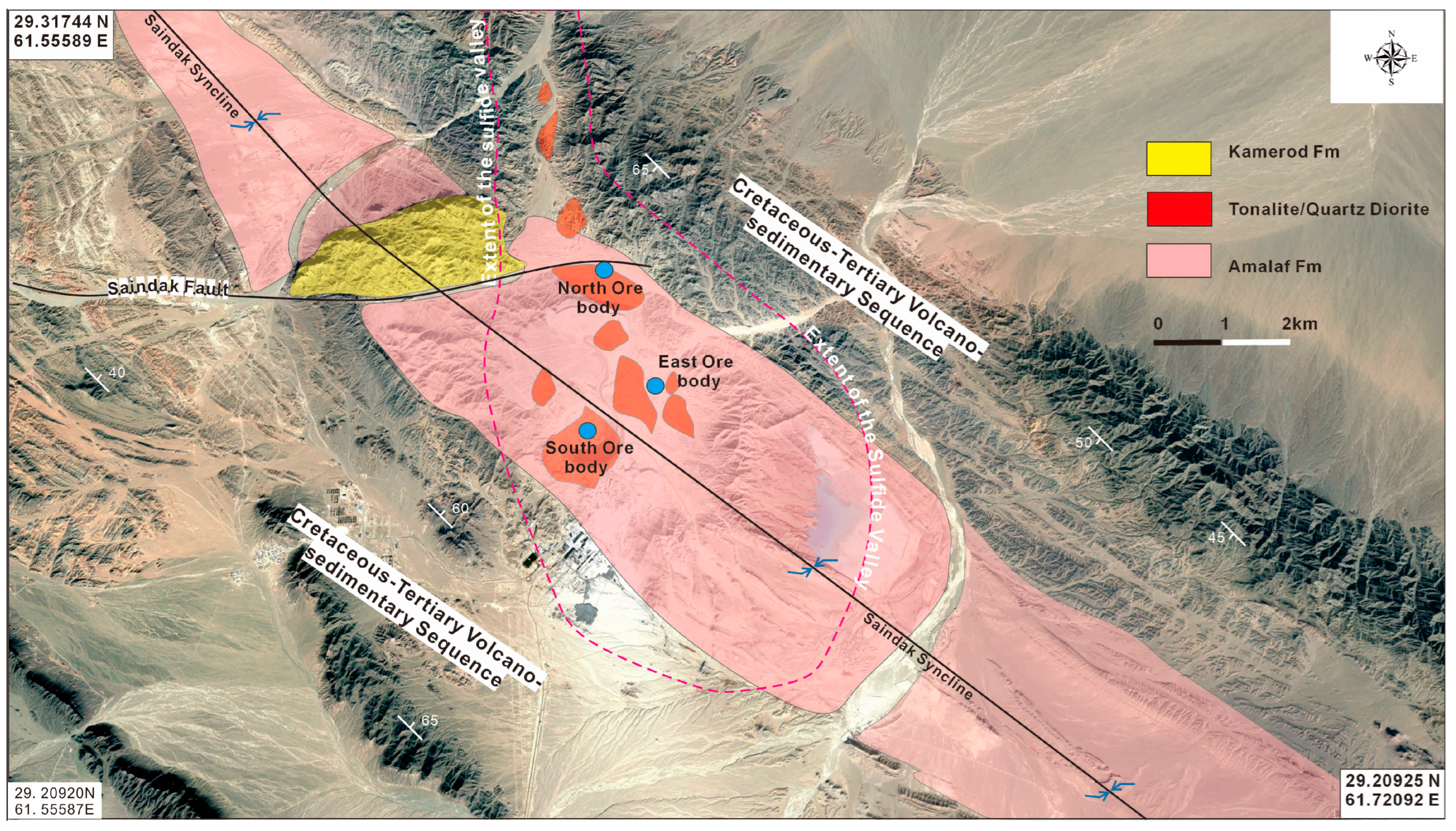
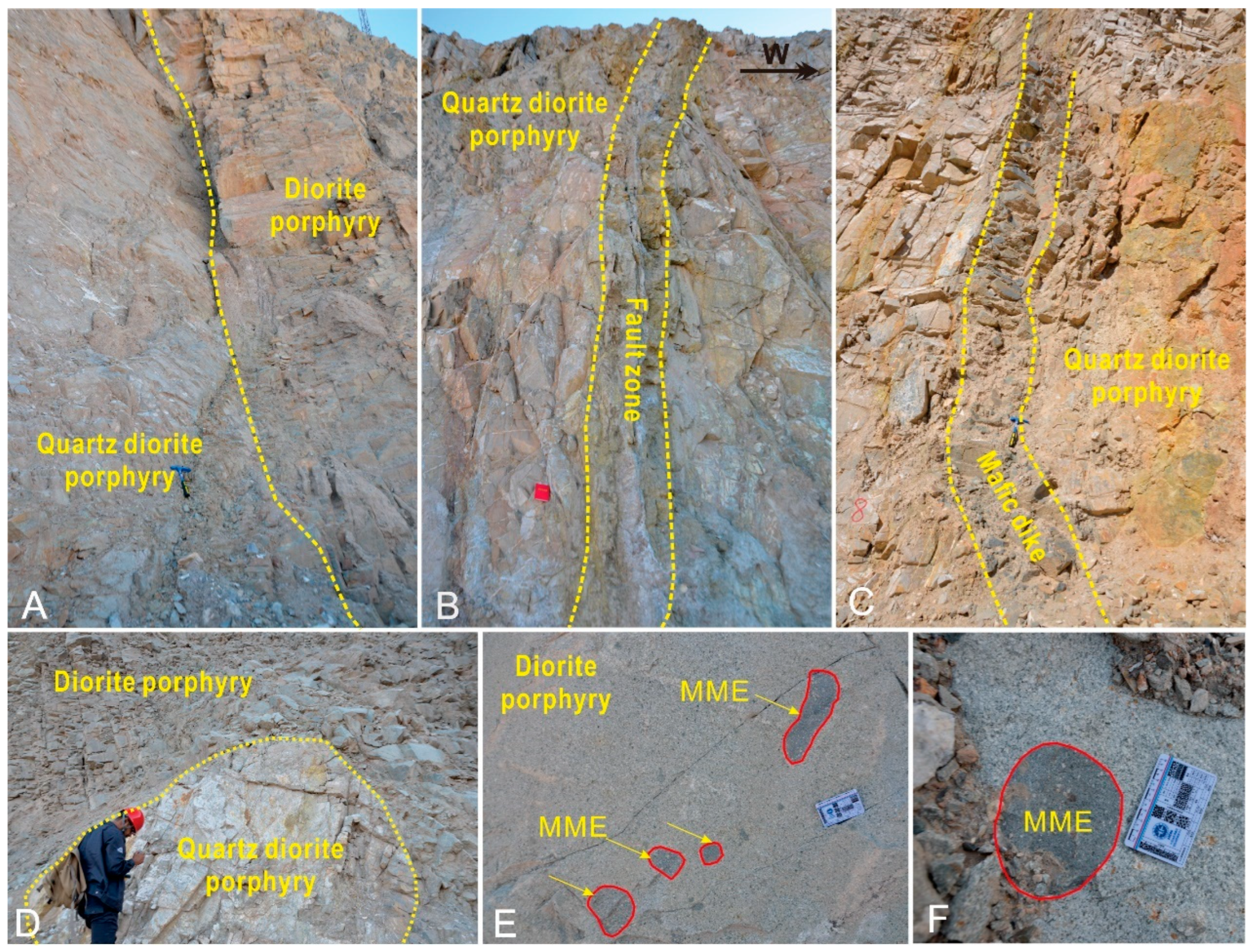
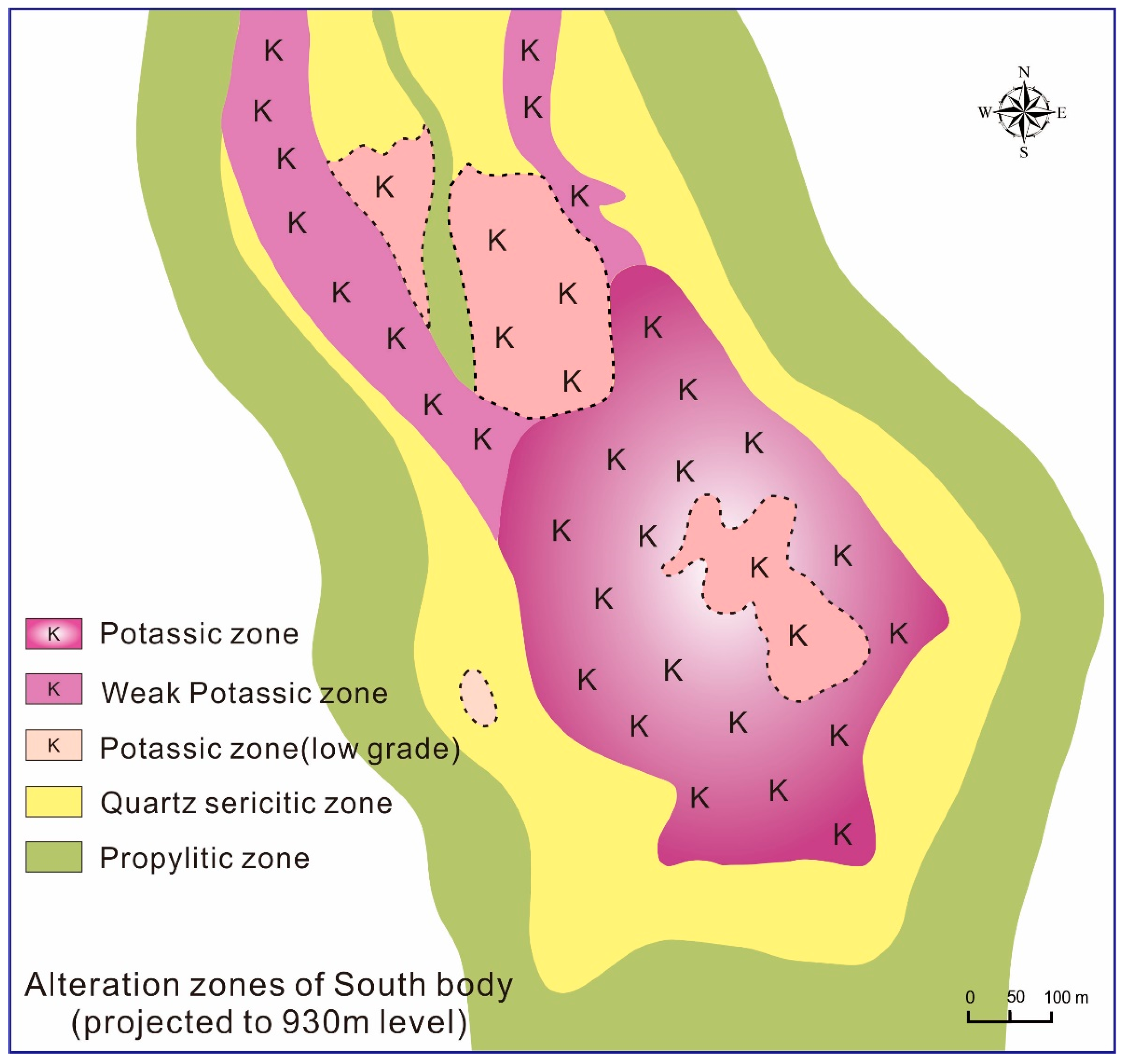
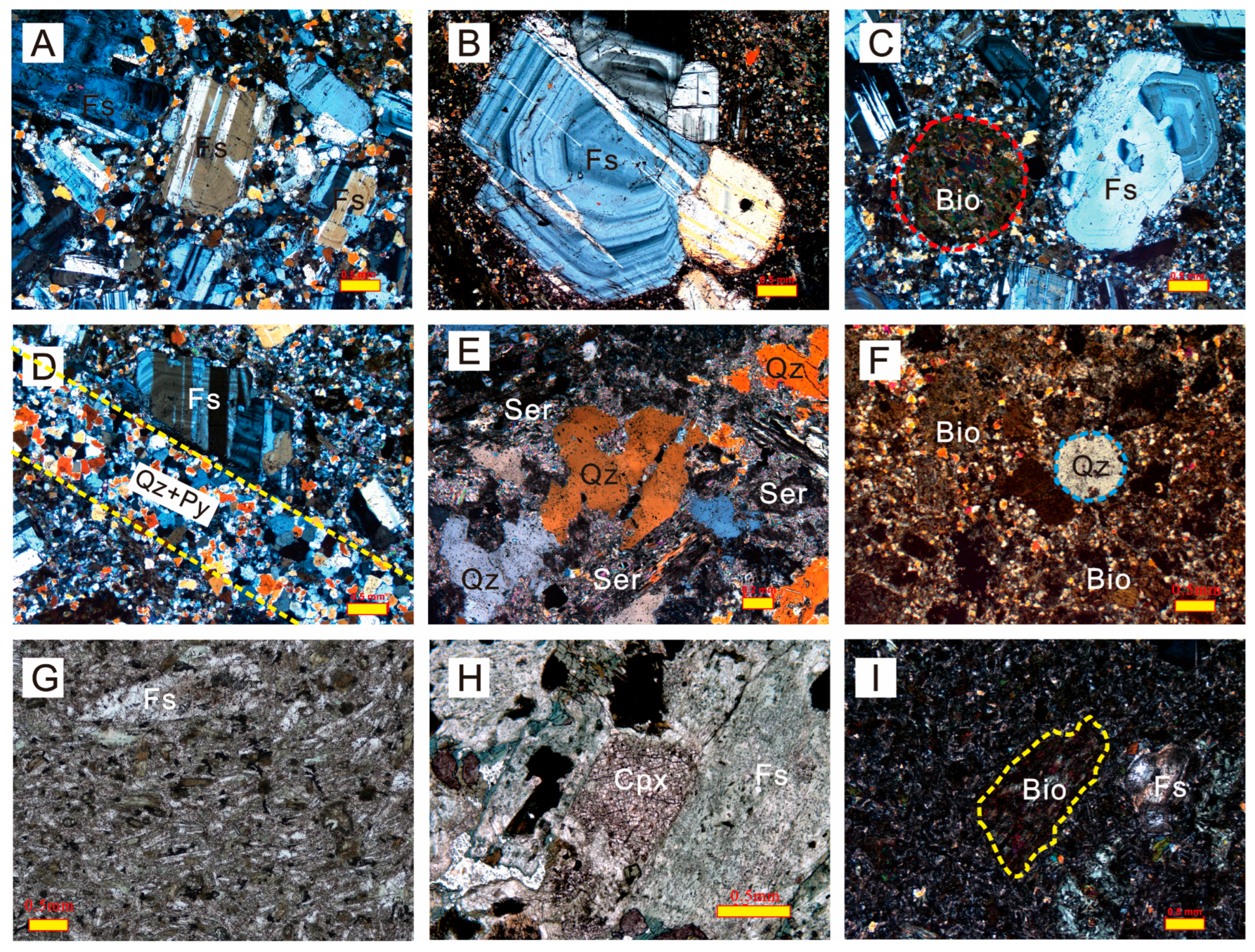
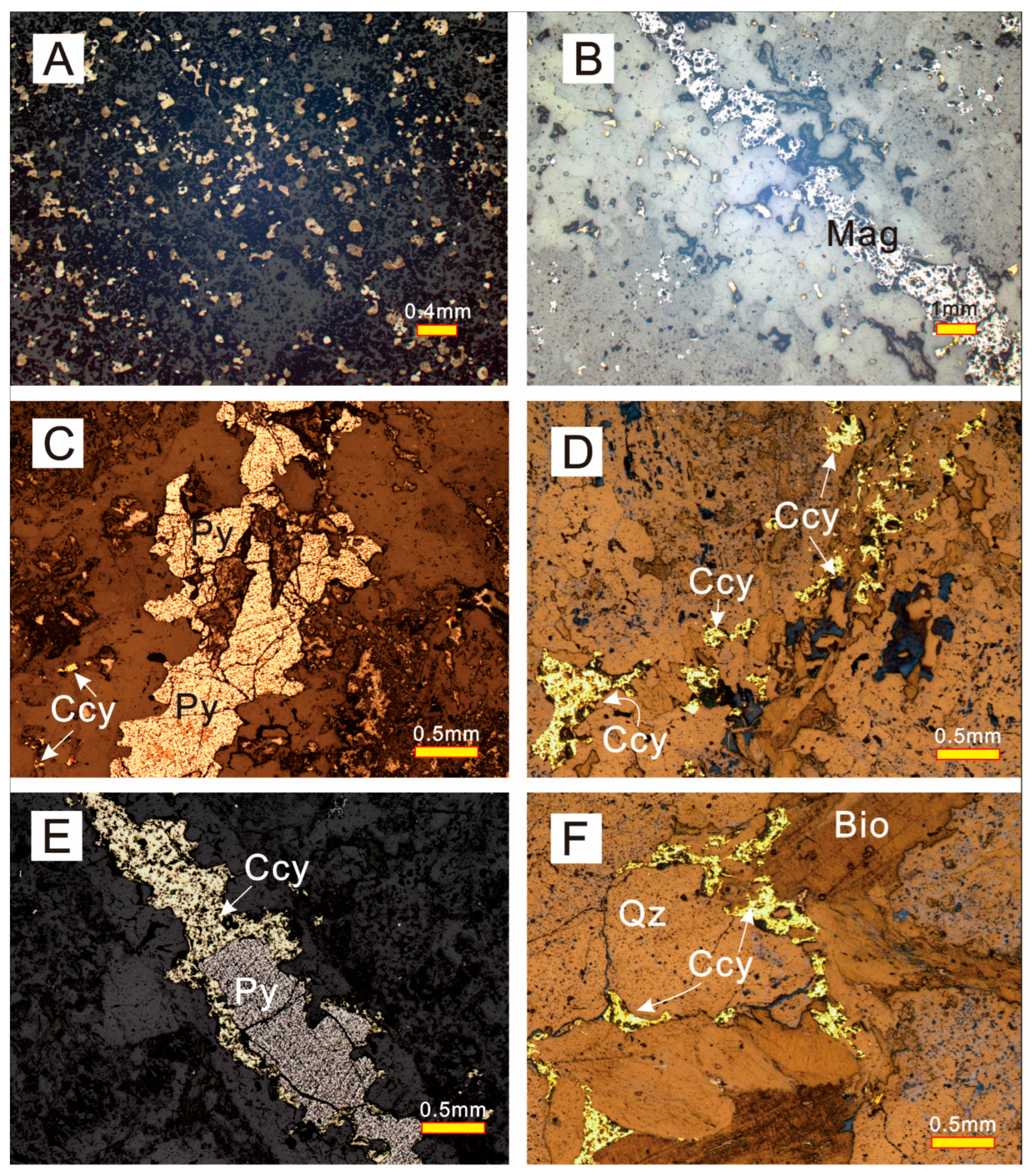
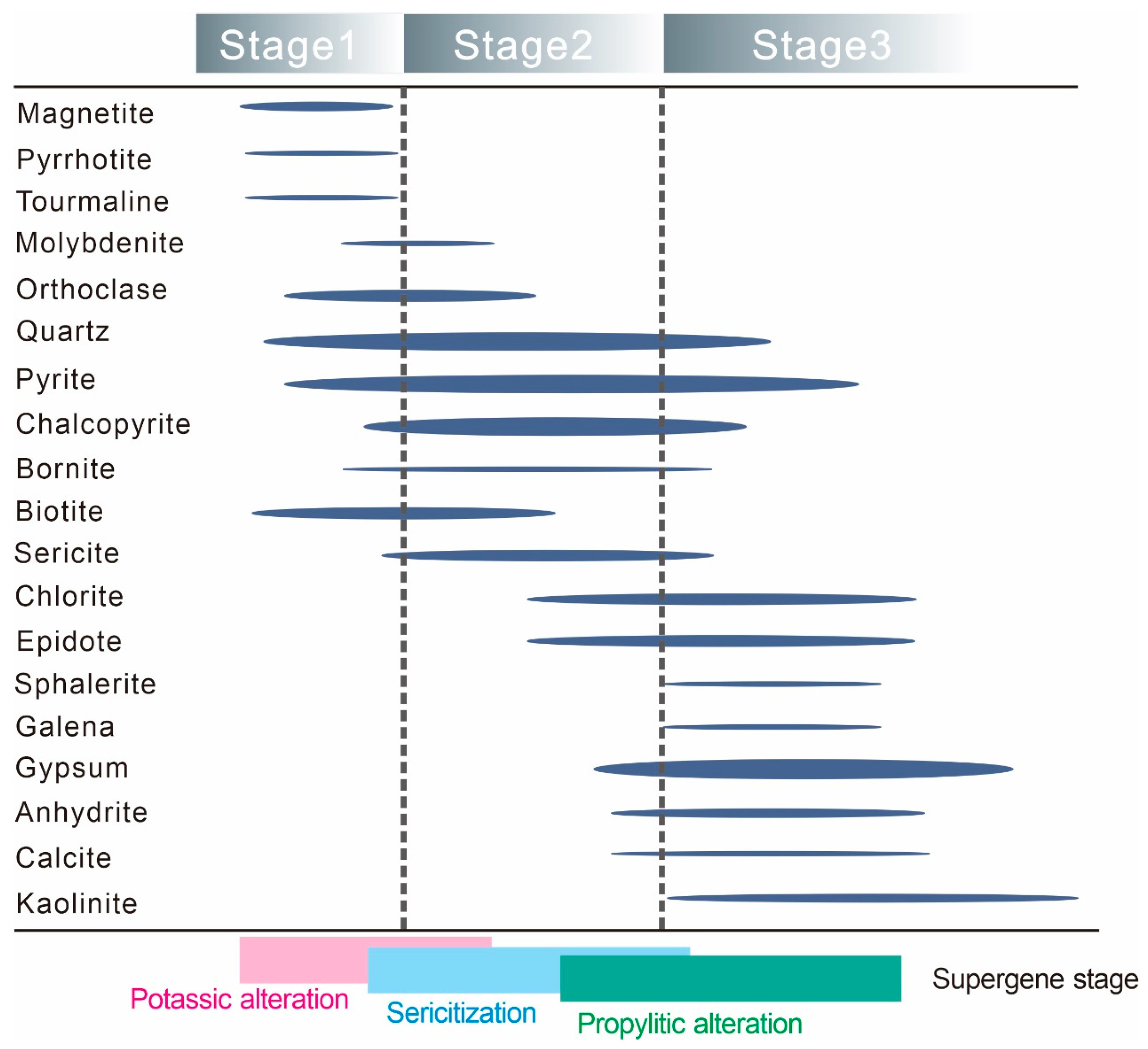
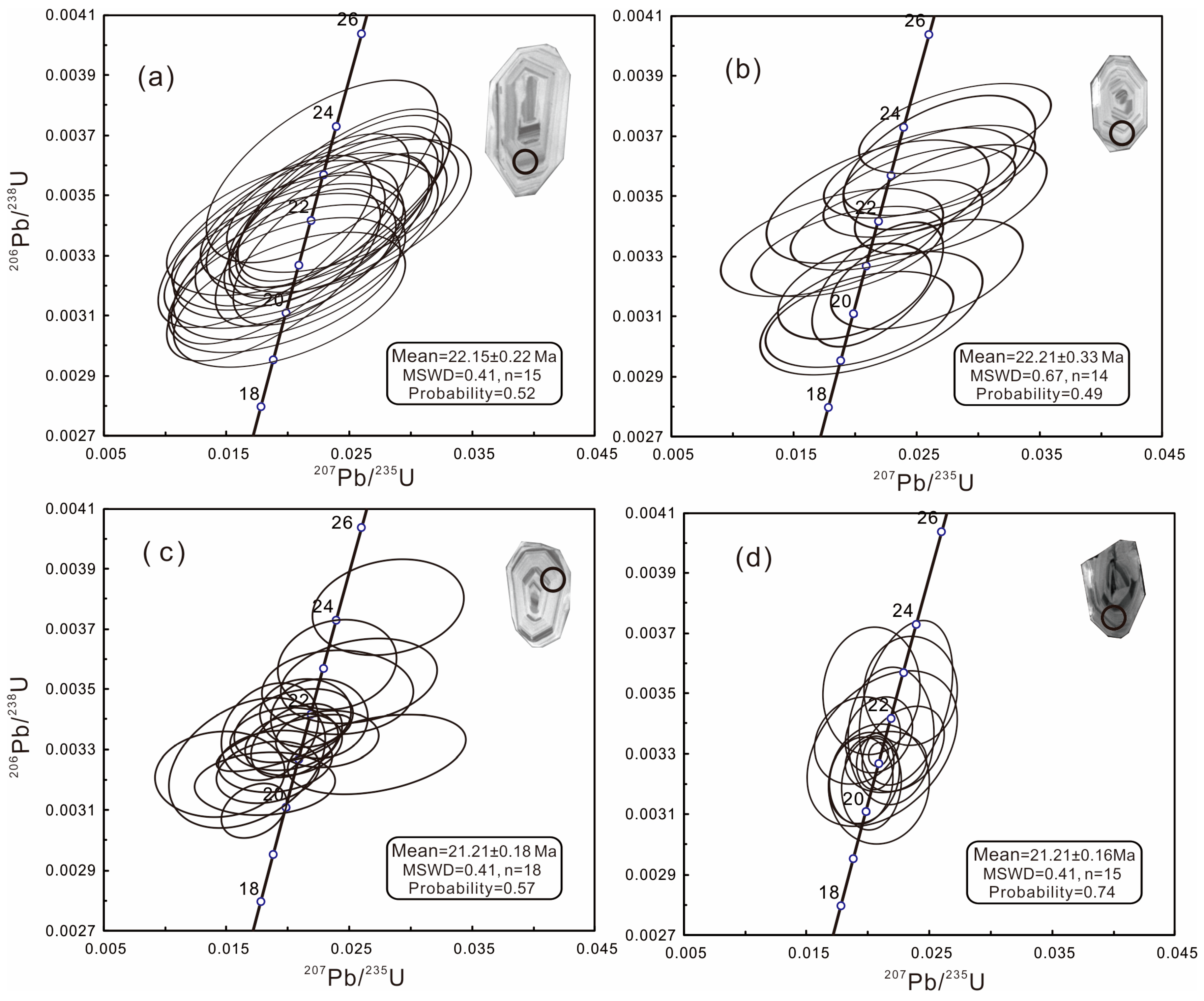
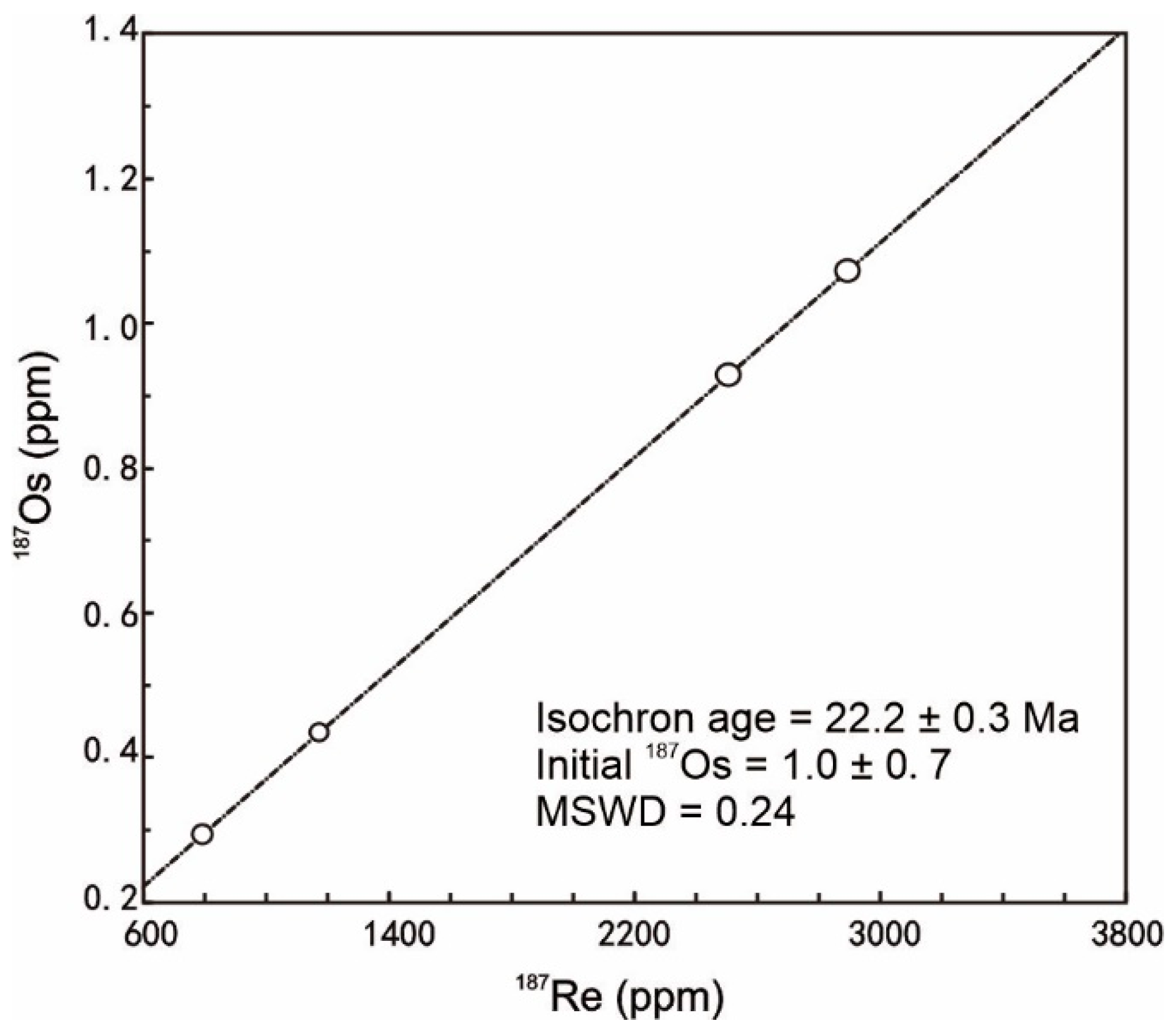
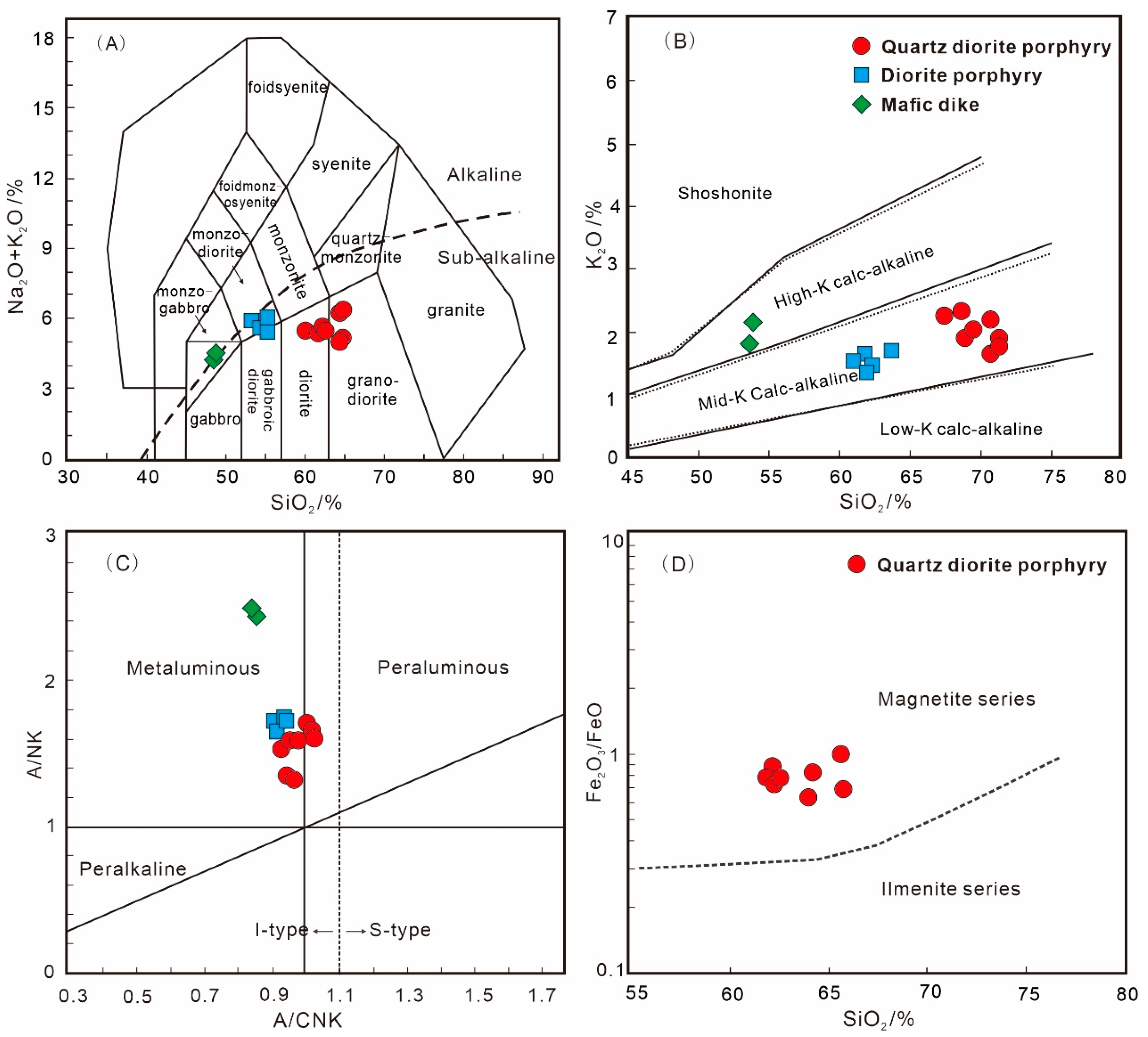
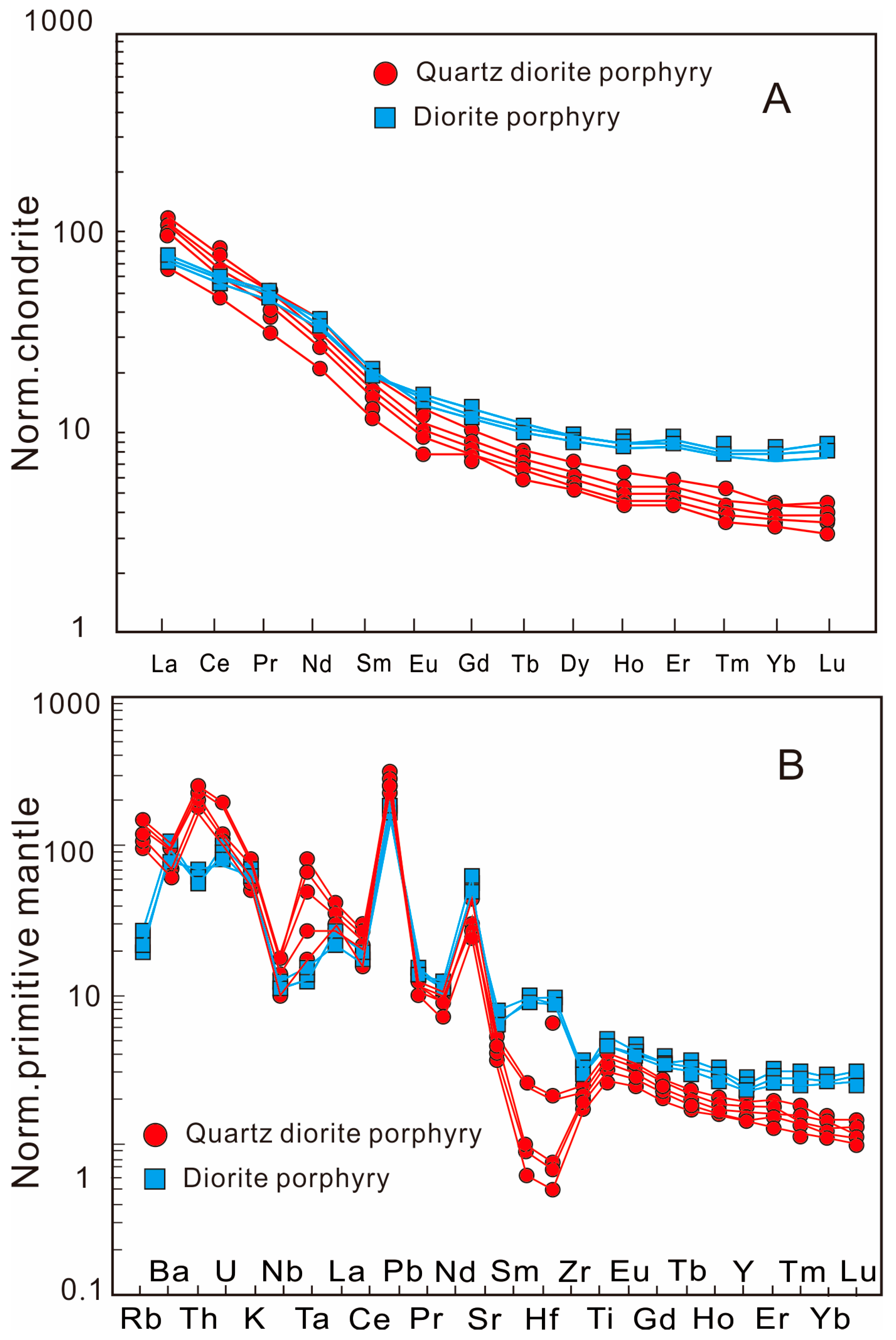
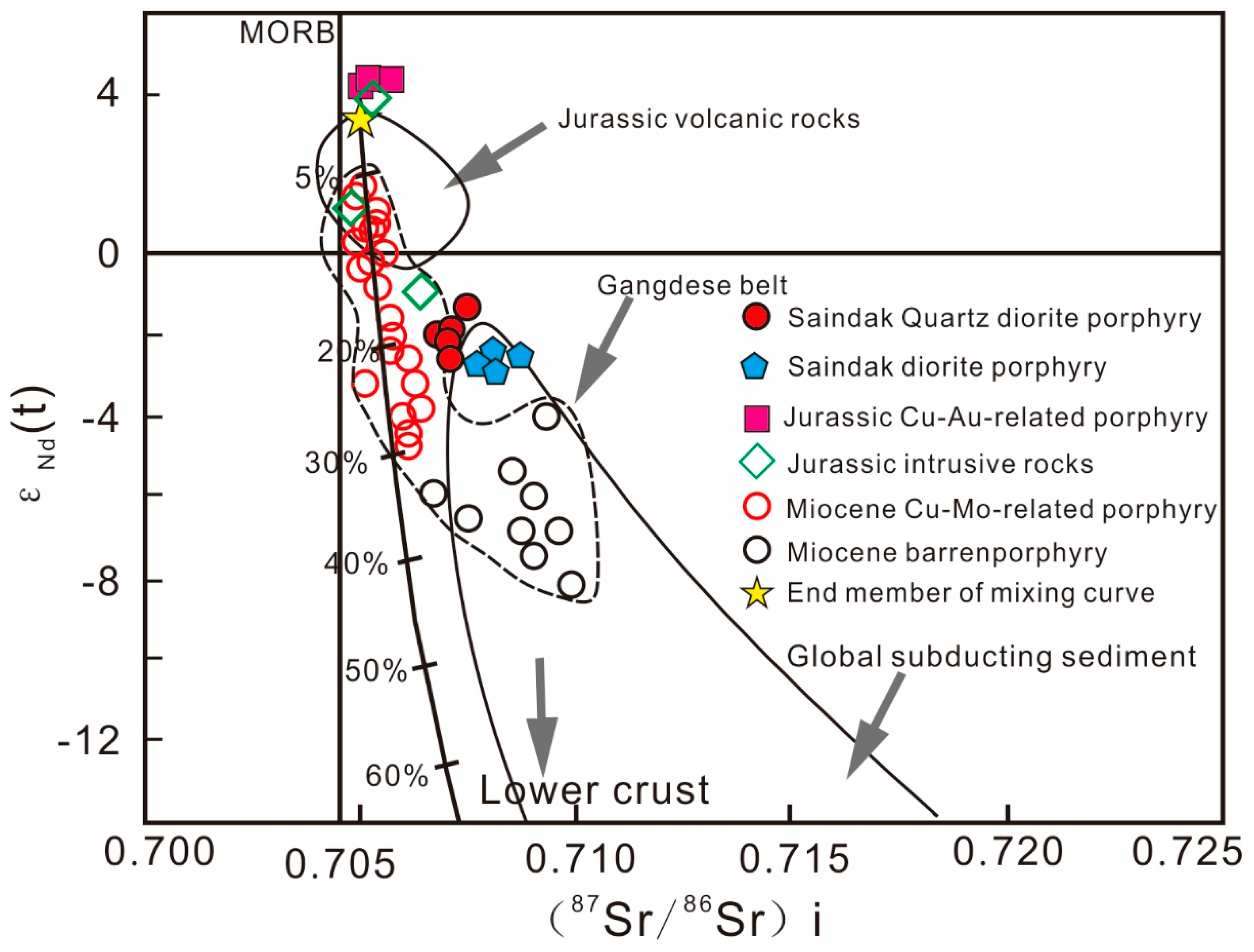
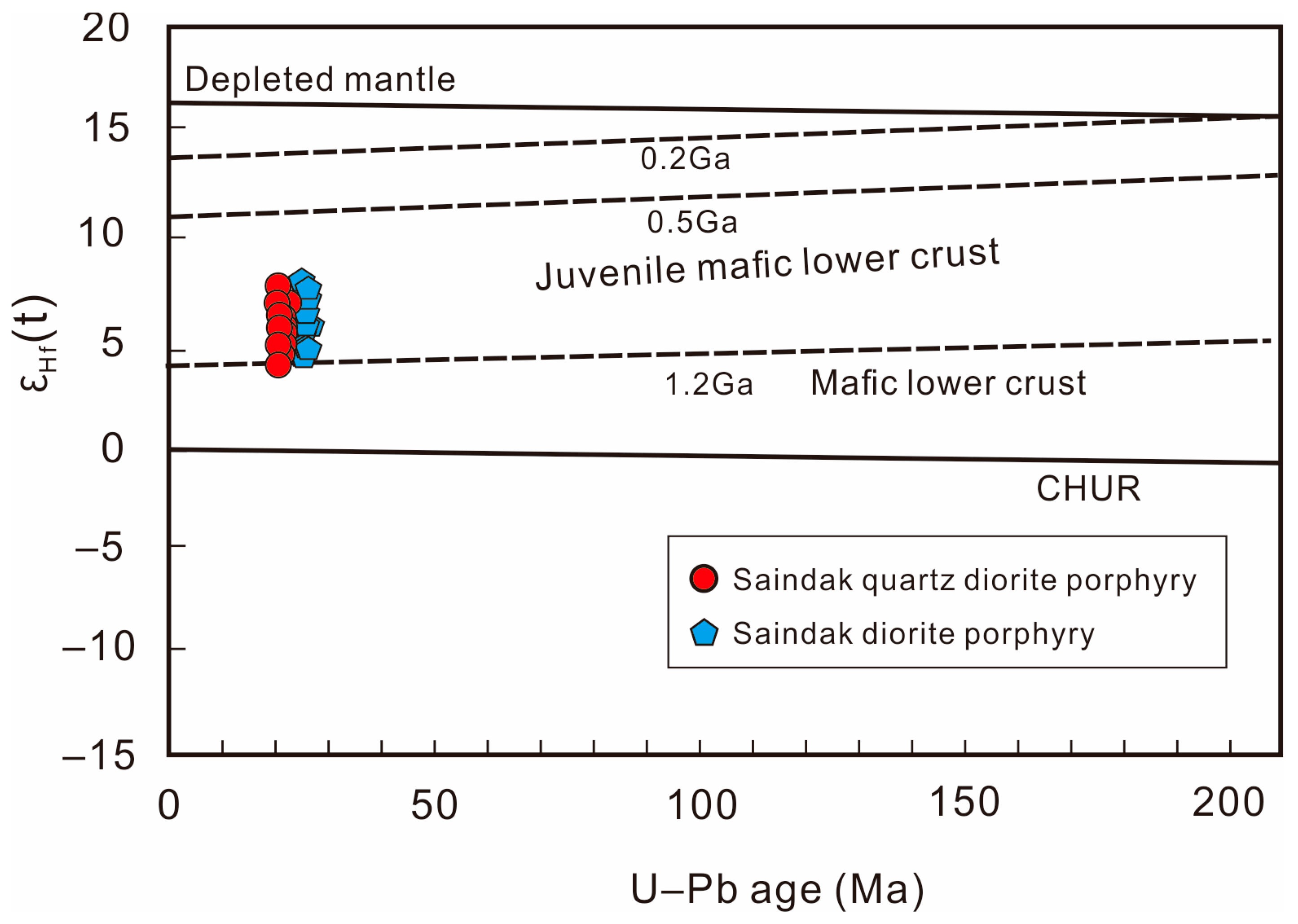

| No. | Weight (g) | Re (μg/g) | Normal Os (μg/g) | 187Re (μg/g) | 187Os (μg/g) | Model Age | |||||
|---|---|---|---|---|---|---|---|---|---|---|---|
| Measured | 2 δ | Measured | 2 δ | Measured | 2 δ | Measured | 2 δ | Measured | 2 δ | ||
| SK-01 | 0.00800 | 1281.88 | 21.17 | 0.0419 | 0.0257 | 805.69 | 13.30 | 0.3000 | 0.0017 | 22.35 | 0.45 |
| SK-02 | 0.00211 | 1836.63 | 12.57 | 0.1777 | 0.0079 | 1150.44 | 0.790 | 0.4217 | 0.0029 | 21.93 | 0.30 |
| SK-03 | 0.00123 | 3977.79 | 41.78 | 0.4357 | 0.0132 | 2500.12 | 26.26 | 0.9272 | 0.0072 | 22.26 | 0.36 |
| SK-04 | 0.05 | 4604.89 | 34.75 | 0.73 | 0.0419 | 2894.26 | 21.84 | 0.1076 | 0.0083 | 22.30 | 0.33 |
| No. | NS-1 | NS-2 | NS-3 | NS-4 | NA2-1 | NA2-2 | NA2-3 | NA2-4 | NE-1 * | NE-2 * | NE-3 * | NE-4 * | NS10-1 | NS10-2 |
|---|---|---|---|---|---|---|---|---|---|---|---|---|---|---|
| Sample | QDP | QDP | QDP | QDP | QDP | QDP | QDP | QDP | DP | DP | DP | DP | Gabbro | Gabbro |
| SiO2 | 62.12 | 62.32 | 61.92 | 62.2 | 65.8 | 65.7 | 63.96 | 64.19 | 54.05 | 54.31 | 54.21 | 53.57 | 47.96 | 48.11 |
| TiO2 | 0.45 | 0.43 | 0.42 | 0.43 | 0.4 | 0.42 | 0.44 | 0.44 | 0.65 | 0.63 | 0.63 | 0.63 | 0.9 | 0.9 |
| Al2O3 | 16.05 | 16.18 | 16.01 | 16.23 | 16.14 | 15.64 | 16.55 | 16.43 | 18.26 | 18.08 | 18.28 | 18.14 | 15.3 | 15.43 |
| FeO | 2.25 | 2.25 | 2.35 | 2.28 | 1.88 | 2.05 | 2.45 | 2.02 | 6.65 | 6.7 | ||||
| Fe2O3 | 1.92 | 1.71 | 1.74 | 1.69 | 1.3 | 2.04 | 1.48 | 1.73 | 7.65 | 7.60 | 7.47 | 7.53 | 3.02 | 2.8 |
| MnO | 0.07 | 0.069 | 0.074 | 0.069 | 0.082 | 0.039 | 0.046 | 0.06 | 0.14 | 0.14 | 0.14 | 0.14 | 0.12 | 0.11 |
| MgO | 3.1 | 3.08 | 3.06 | 3.09 | 2.19 | 2.27 | 2.39 | 2.34 | 4.40 | 4.25 | 4.28 | 4.28 | 9.86 | 10.07 |
| CaO | 5.48 | 5.47 | 5.52 | 5.49 | 3.91 | 3.47 | 4.82 | 4.4 | 5.92 | 5.99 | 5.85 | 5.76 | 6.61 | 6.53 |
| Na2O | 3.68 | 3.86 | 3.88 | 3.84 | 3.49 | 3.44 | 3.49 | 3.38 | 4.31 | 4.28 | 4.33 | 4.39 | 2.52 | 2.7 |
| K2O | 2.04 | 2.05 | 1.6 | 2.02 | 1.6 | 2.15 | 1.15 | 1.46 | 1.50 | 1.50 | 1.58 | 1.51 | 2.11 | 1.68 |
| P2O5 | 0.13 | 0.13 | 0.13 | 0.14 | 0.14 | 0.14 | 0.15 | 0.15 | 0.21 | 0.21 | 0.21 | 0.21 | 0.27 | 0.28 |
| LOI | 2.53 | 2.26 | 3.12 | 2.36 | 2.79 | 2.39 | 2.91 | 3.2 | 2.56 | 2.80 | 2.54 | 2.72 | 4.43 | 4.4 |
| Total | 99.82 | 99.81 | 99.82 | 99.84 | 99.72 | 99.75 | 99.84 | 99.80 | 99.66 | 99.75 | ||||
| K2O/Na2O | 0.55 | 0.53 | 0.41 | 0.53 | 0.46 | 0.63 | 0.33 | 0.43 | 0.35 | 0.35 | 0.36 | 0.34 | 0.84 | 0.62 |
| K2O + Na2O | 5.72 | 5.91 | 5.48 | 5.86 | 5.09 | 5.59 | 4.64 | 4.84 | 5.81 | 5.78 | 5.91 | 5.90 | 4.63 | 4.38 |
| Li | 10.1 | 10.1 | 11.6 | 10.2 | 14.2 | 13.6 | 15.1 | 15.9 | 13.2 | 14 | ||||
| Be | 2.21 | 2.32 | 2.24 | 2.38 | 3.34 | 3.52 | 3.08 | 2.98 | 2.41 | 2.46 | ||||
| Sc | 15.4 | 15.7 | 14 | 14.6 | 13 | 11.6 | 12.6 | 12 | 31.7 | 31.2 | ||||
| V | 114 | 96.4 | 91.5 | 94.6 | 92.3 | 90.8 | 100 | 101 | 223 | 224 | ||||
| Cr | 79.7 | 76.1 | 76.1 | 78 | 30.3 | 31.4 | 31.7 | 26.3 | 441 | 464 | ||||
| Co | 12.2 | 11 | 11.5 | 11 | 13.3 | 11.3 | 10.6 | 7.22 | 20 | 20.6 | ||||
| Ni | 37.8 | 36.6 | 36.6 | 36.8 | 17.7 | 17.2 | 17.4 | 14.5 | 171 | 176 | ||||
| Cu | 33.1 | 48 | 20.6 | 16.4 | 827 | 410 | 119 | 63.4 | 306 | 914 | ||||
| Zn | 81.2 | 72.8 | 78.8 | 73.3 | 122 | 101 | 128 | 188 | 136 | 141 | ||||
| Ga | 17.5 | 17.3 | 17.4 | 17.3 | 17.5 | 17.2 | 18.9 | 17.8 | 19.3 | 20.6 | ||||
| Rb | 79.2 | 76.1 | 63.1 | 71.9 | 53.8 | 60 | 38.8 | 52.1 | 12.7 | 17.1 | 13.9 | 13.2 | 80.1 | 78.4 |
| Sr | 703 | 722 | 755 | 675 | 644 | 641 | 756 | 686 | 1275 | 1390 | 1315 | 1360 | 567 | 603 |
| Ba | 929 | 823 | 672 | 712 | 665 | 912 | 607 | 648 | 750 | 800 | 810 | 800 | 538 | 435 |
| Zr | 74.8 | 76.2 | 76 | 70.6 | 67.5 | 86.9 | 59.5 | 56.8 | 95.4 | 101.5 | 105.5 | 101.0 | 115 | 122 |
| Hf | 3.05 | 2.33 | 2.28 | 2.17 | 2.27 | 2.73 | 2.04 | 1.97 | 2.7 | 2.9 | 2.9 | 2.9 | 3.08 | 3.28 |
| Nb | 7.69 | 7.91 | 7.51 | 7.8 | 10.4 | 12.3 | 10.8 | 10 | 6.8 | 7.3 | 7.4 | 7.4 | 12.1 | 12.5 |
| Ta | 0.80 | 0.77 | 0.72 | 0.73 | 0.95 | 1.04 | 0.86 | 0.80 | 0.45 | 0.44 | 0.47 | 0.46 | 0.76 | 0.76 |
| Cs | 1.63 | 1.46 | 1.7 | 1.42 | 3 | 2.97 | 2.79 | 3.66 | 5.09 | 8.5 | ||||
| La | 31.6 | 31 | 30.2 | 30.5 | 35.5 | 42.6 | 45.3 | 43.3 | 15.4 | 16.9 | 15.6 | 15.7 | 61.5 | 66.5 |
| Ce | 49.6 | 48.1 | 47.2 | 47.4 | 56.9 | 67 | 69.7 | 65.8 | 33.4 | 35.6 | 34.7 | 35.4 | 111 | 122 |
| Pr | 5.09 | 4.9 | 4.83 | 4.84 | 6.09 | 6.7 | 7.61 | 7.1 | 3.93 | 4.16 | 4.03 | 4.09 | 12.5 | 13.4 |
| Nd | 16.4 | 15.7 | 15.8 | 15.3 | 19.4 | 20.2 | 24.1 | 22.7 | 15.2 | 15.8 | 15.4 | 15.7 | 43.7 | 45.2 |
| Sm | 2.67 | 2.58 | 2.49 | 2.49 | 3.18 | 2.93 | 3.64 | 3.38 | 2.95 | 3.00 | 2.88 | 2.97 | 6.46 | 6.88 |
| Eu | 0.94 | 0.88 | 0.82 | 0.87 | 0.98 | 0.91 | 1.00 | 0.99 | 0.79 | 0.79 | 0.79 | 0.86 | 1.62 | 1.54 |
| Gd | 2.34 | 2.24 | 2.10 | 2.21 | 2.71 | 2.40 | 3.14 | 2.93 | 2.45 | 2.52 | 2.58 | 2.63 | 5.42 | 5.64 |
| Tb | 0.38 | 0.36 | 0.33 | 0.34 | 0.41 | 0.35 | 0.47 | 0.44 | 0.38 | 0.39 | 0.40 | 0.40 | 0.80 | 0.82 |
| Dy | 1.79 | 1.70 | 1.63 | 1.61 | 2.14 | 1.70 | 2.28 | 2.32 | 2.29 | 2.39 | 2.46 | 2.44 | 3.79 | 3.92 |
| Ho | 0.38 | 0.34 | 0.32 | 0.32 | 0.42 | 0.33 | 0.45 | 0.45 | 0.48 | 0.49 | 0.51 | 0.50 | 0.72 | 0.74 |
| Er | 0.89 | 0.81 | 0.80 | 0.78 | 1.06 | 0.84 | 1.12 | 1.20 | 1.43 | 1.47 | 1.51 | 1.50 | 1.78 | 1.87 |
| Tm | 0.18 | 0.17 | 0.15 | 0.15 | 0.19 | 0.16 | 0.20 | 0.20 | 0.20 | 0.21 | 0.21 | 0.21 | 0.31 | 0.33 |
| Yb | 1.08 | 1.04 | 0.92 | 0.99 | 1.30 | 1.11 | 1.40 | 1.34 | 1.32 | 1.36 | 1.40 | 1.35 | 1.94 | 2.07 |
| Lu | 0.19 | 0.17 | 0.15 | 0.16 | 0.20 | 0.17 | 0.20 | 0.22 | 0.20 | 0.22 | 0.22 | 0.21 | 0.28 | 0.31 |
| Y | 10.4 | 9.15 | 9.07 | 8.73 | 11.9 | 9.4 | 13.4 | 13.3 | 11.5 | 11.9 | 11.7 | 11.9 | 19.7 | 19.6 |
| Pb | 26.7 | 25.3 | 23.4 | 27.7 | 51 | 29.6 | 28.1 | 46.6 | 12.9 | 12.9 | 13.1 | 13.6 | 12.3 | 13.3 |
| Th | 21.0 | 20.9 | 21.5 | 20.2 | 29.8 | 37.1 | 26.8 | 26.8 | 5.30 | 5.97 | 5.61 | 5.53 | 14.9 | 15.4 |
| U | 4.98 | 5.00 | 5.40 | 4.72 | 4.35 | 5.72 | 9.30 | 3.78 | 1.7 | 1.7 | 1.9 | 2.4 | 3.67 | 3.90 |
| Mg# | 58.18 | 59.20 | 58.25 | 59.21 | 56.18 | 51.05 | 53.01 | 53.87 | 53.29 | 52.59 | 53.20 | 53.00 | 65.27 | 66.10 |
| Sr/Y | 67.60 | 78.91 | 83.24 | 77.32 | 54.12 | 68.19 | 56.42 | 51.58 | 110.9 | 116.8 | 112.4 | 114.3 | 28.78 | 30.77 |
| ΣREE | 113.5 | 110.0 | 107.7 | 108.0 | 130.5 | 147.4 | 160.6 | 152.4 | 80.42 | 85.30 | 82.69 | 83.96 | 251.8 | 271.2 |
| LREE/ HREE | 14.68 | 15.13 | 15.82 | 15.48 | 14.46 | 19.86 | 16.34 | 15.75 | 8.19 | 8.43 | 7.90 | 8.09 | 15.73 | 16.28 |
| LaN/YbN | 19.73 | 20.10 | 22.08 | 20.88 | 18.41 | 25.87 | 21.81 | 21.79 | 7.87 | 8.38 | 7.51 | 7.84 | 21.37 | 21.66 |
| δEu | 1.12 | 1.10 | 1.06 | 1.12 | 1.00 | 1.02 | 0.88 | 0.94 | 0.87 | 0.86 | 0.87 | 0.92 | 0.82 | 0.73 |
| δCe | 0.85 | 0.85 | 0.85 | 0.85 | 0.86 | 0.86 | 0.83 | 0.82 | 1.01 | 0.99 | 1.03 | 1.04 | 0.91 | 0.93 |
| No. | Rock Name | Age/Ma | Rb | Sr | 87Rb/ 86Sr | 87Sr/ 86Sr | 2σ | 87Sr/ 86Sr i | Sm | Nd | 147Sm/ 144Nd | 143Nd/ 144Nd | 2σ | εNd(t) |
|---|---|---|---|---|---|---|---|---|---|---|---|---|---|---|
| NS-1 | QDP | 22 | 79.2 | 703 | 0.32587 | 0.706581 | 0.000008 | 0.706481 | 2.67 | 16.4 | 0.09838 | 0.512589 | 0.000002 | −0.7 |
| NS-2 | QDP | 22 | 76.1 | 722 | 0.30488 | 0.706596 | 0.000008 | 0.706502 | 2.58 | 15.7 | 0.09930 | 0.512577 | 0.000003 | −0.9 |
| NA2-1 | QDP | 22 | 53.8 | 644 | 0.24165 | 0.706968 | 0.000008 | 0.706894 | 3.18 | 19.4 | 0.09905 | 0.512526 | 0.000003 | −1.9 |
| NA2-2 | QDP | 22 | 60.0 | 641 | 0.27076 | 0.706987 | 0.000008 | 0.706904 | 2.93 | 20.2 | 0.08765 | 0.512497 | 0.000002 | −2.4 |
| NA2-3 | QDP | 22 | 38.8 | 756 | 0.14846 | 0.706906 | 0.000008 | 0.706860 | 3.64 | 24.1 | 0.09127 | 0.512536 | 0.000002 | −1.7 |
| NA2-4 | QDP | 22 | 52.1 | 686 | 0.21969 | 0.706961 | 0.000008 | 0.706893 | 3.38 | 22.7 | 0.08997 | 0.512540 | 0.000002 | −1.6 |
| NE-1 * | DP | 22 | 61.8 | 909 | 0.19666 | 0.706710 | 0.0000012 | 0.706650 | 2.82 | 17.00 | −1.7 | |||
| NE-2 * | DP | 22 | 12.7 | 1275 | 0.02881 | 0.707185 | 0.0000012 | 0.707176 | 2.95 | 15.20 | −1.1 | |||
| NE-3 * | DP | 22 | 13.9 | 1315 | 0.03058 | 0.707191 | 0.0000012 | 0.707182 | 2.88 | 15.40 | −1.2 | |||
| NE-4 * | DP | 22 | 13.2 | 1360 | 0.02808 | 0.707168 | 0.0000012 | 0.707159 | 2.97 | 15.70 | −1.1 | |||
| NS10-1 | Gabbro | 22 | 80.1 | 567 | 0.40865 | 0.707092 | 0.000006 | 0.706966 | 6.46 | 43.7 | 0.08932 | 0.512473 | 0.000003 | −2.9 |
| NS10-2 | Gabbro | 22 | 78.4 | 603 | 0.37610 | 0.707160 | 0.000008 | 0.707044 | 6.88 | 45.2 | 0.09198 | 0.512469 | 0.000003 | −3.0 |
| No. | 176Hf/ 177Hf | 2σ | 176Lu/ 177Hf | 176Yb/ 177Hf | Hf i | εHf (t) | 1σ | TDM1/ Ga | 1σ | TDM2/Ga | 1σ |
|---|---|---|---|---|---|---|---|---|---|---|---|
| NS-01 | 0.282925 | 0.000013 | 0.000778 | 0.026004 | 0.28292 | 5.9 | 0.4 | 0.461 | 0.018 | 0.724 | 0.018 |
| NS-02 | 0.282893 | 0.000015 | 0.000717 | 0.024344 | 0.28289 | 4.7 | 0.5 | 0.506 | 0.021 | 0.798 | 0.021 |
| NS-03 | 0.282912 | 0.000017 | 0.000773 | 0.025742 | 0.28291 | 5.4 | 0.6 | 0.480 | 0.023 | 0.755 | 0.023 |
| NS-04 | 0.282929 | 0.000016 | 0.000693 | 0.022535 | 0.28293 | 6.0 | 0.5 | 0.455 | 0.022 | 0.717 | 0.022 |
| NS-05 | 0.282931 | 0.000015 | 0.000796 | 0.026923 | 0.28293 | 6.1 | 0.5 | 0.454 | 0.021 | 0.713 | 0.021 |
| NS-06 | 0.282964 | 0.000016 | 0.000525 | 0.017685 | 0.28296 | 7.3 | 0.6 | 0.403 | 0.022 | 0.637 | 0.022 |
| NS-07 | 0.282901 | 0.000015 | 0.000507 | 0.017583 | 0.28290 | 5.1 | 0.5 | 0.491 | 0.021 | 0.778 | 0.021 |
| NS-08 | 0.282963 | 0.000014 | 0.000826 | 0.027814 | 0.28296 | 7.2 | 0.5 | 0.408 | 0.020 | 0.638 | 0.020 |
| NS-09 | 0.282915 | 0.000015 | 0.001291 | 0.045223 | 0.28291 | 5.5 | 0.5 | 0.482 | 0.022 | 0.748 | 0.022 |
| NS-10 | 0.282942 | 0.000014 | 0.000600 | 0.020135 | 0.28294 | 6.5 | 0.5 | 0.436 | 0.020 | 0.688 | 0.020 |
| NS-11 | 0.282938 | 0.000015 | 0.000815 | 0.027699 | 0.28294 | 6.4 | 0.5 | 0.443 | 0.021 | 0.695 | 0.021 |
| NS-12 | 0.282922 | 0.000015 | 0.000540 | 0.017766 | 0.28292 | 5.8 | 0.5 | 0.463 | 0.021 | 0.732 | 0.021 |
| NS-13 | 0.282950 | 0.000015 | 0.000615 | 0.020443 | 0.28295 | 6.8 | 0.5 | 0.424 | 0.022 | 0.668 | 0.022 |
| NS-14 | 0.282907 | 0.000017 | 0.000710 | 0.024036 | 0.28291 | 5.3 | 0.6 | 0.485 | 0.024 | 0.765 | 0.024 |
| NS-15 | 0.282944 | 0.000016 | 0.000856 | 0.028875 | 0.28294 | 6.5 | 0.6 | 0.435 | 0.023 | 0.682 | 0.023 |
| NS-16 | 0.282915 | 0.000016 | 0.000586 | 0.019505 | 0.28291 | 5.5 | 0.6 | 0.473 | 0.023 | 0.747 | 0.023 |
| NE-01 | 0.282932 | 0.000016 | 0.000718 | 0.024164 | 0.28293 | 6.1 | 0.5 | 0.450 | 0.022 | 0.709 | 0.022 |
| NE-02 | 0.282945 | 0.000017 | 0.001083 | 0.037623 | 0.28294 | 6.6 | 0.6 | 0.437 | 0.025 | 0.681 | 0.025 |
| NE-03 | 0.282920 | 0.000016 | 0.000332 | 0.011218 | 0.28292 | 5.7 | 0.5 | 0.463 | 0.022 | 0.737 | 0.022 |
| NE-04 | 0.282958 | 0.000015 | 0.000552 | 0.018708 | 0.28296 | 7.1 | 0.5 | 0.412 | 0.021 | 0.650 | 0.021 |
| NE-05 | 0.282912 | 0.000020 | 0.001296 | 0.045784 | 0.28291 | 5.4 | 0.7 | 0.486 | 0.028 | 0.755 | 0.028 |
| NE-06 | 0.282918 | 0.000015 | 0.000738 | 0.025122 | 0.28292 | 5.6 | 0.5 | 0.471 | 0.021 | 0.741 | 0.021 |
| NE-07 | 0.282901 | 0.000016 | 0.001189 | 0.042671 | 0.28290 | 5.0 | 0.6 | 0.500 | 0.023 | 0.779 | 0.023 |
| NE-08 | 0.282913 | 0.000016 | 0.000836 | 0.028555 | 0.28291 | 5.5 | 0.5 | 0.479 | 0.022 | 0.752 | 0.022 |
| NE-09 | 0.282932 | 0.000016 | 0.000526 | 0.018030 | 0.28293 | 6.1 | 0.5 | 0.448 | 0.022 | 0.709 | 0.022 |
| NE-10 | 0.282939 | 0.000013 | 0.000556 | 0.019108 | 0.28294 | 6.4 | 0.5 | 0.440 | 0.019 | 0.694 | 0.019 |
| NE-11 | 0.282932 | 0.000015 | 0.000550 | 0.018630 | 0.28293 | 6.1 | 0.5 | 0.448 | 0.021 | 0.708 | 0.021 |
| NE-12 | 0.282920 | 0.000014 | 0.000887 | 0.030540 | 0.28292 | 5.7 | 0.5 | 0.469 | 0.020 | 0.736 | 0.020 |
| NE-13 | 0.282947 | 0.000015 | 0.000550 | 0.018457 | 0.28295 | 6.6 | 0.5 | 0.428 | 0.021 | 0.676 | 0.021 |
| NE-14 | 0.282909 | 0.000014 | 0.000641 | 0.022148 | 0.28291 | 5.3 | 0.5 | 0.482 | 0.020 | 0.761 | 0.020 |
Disclaimer/Publisher’s Note: The statements, opinions and data contained in all publications are solely those of the individual author(s) and contributor(s) and not of MDPI and/or the editor(s). MDPI and/or the editor(s) disclaim responsibility for any injury to people or property resulting from any ideas, methods, instructions or products referred to in the content. |
© 2025 by the authors. Licensee MDPI, Basel, Switzerland. This article is an open access article distributed under the terms and conditions of the Creative Commons Attribution (CC BY) license (https://creativecommons.org/licenses/by/4.0/).
Share and Cite
Hong, J.; Khalil, Y.S.; Narejo, A.A.; Yang, X.; Khan, T.; Wang, Z.; Tang, H.; Zhang, H.; Yang, B.; Li, W. Magmatic Evolution at the Saindak Cu-Au Deposit: Implications for the Formation of Giant Porphyry Deposits. Minerals 2025, 15, 768. https://doi.org/10.3390/min15080768
Hong J, Khalil YS, Narejo AA, Yang X, Khan T, Wang Z, Tang H, Zhang H, Yang B, Li W. Magmatic Evolution at the Saindak Cu-Au Deposit: Implications for the Formation of Giant Porphyry Deposits. Minerals. 2025; 15(8):768. https://doi.org/10.3390/min15080768
Chicago/Turabian StyleHong, Jun, Yasir Shaheen Khalil, Asad Ali Narejo, Xiaoyong Yang, Tahseenullah Khan, Zhihua Wang, Huan Tang, Haidi Zhang, Bo Yang, and Wenyuan Li. 2025. "Magmatic Evolution at the Saindak Cu-Au Deposit: Implications for the Formation of Giant Porphyry Deposits" Minerals 15, no. 8: 768. https://doi.org/10.3390/min15080768
APA StyleHong, J., Khalil, Y. S., Narejo, A. A., Yang, X., Khan, T., Wang, Z., Tang, H., Zhang, H., Yang, B., & Li, W. (2025). Magmatic Evolution at the Saindak Cu-Au Deposit: Implications for the Formation of Giant Porphyry Deposits. Minerals, 15(8), 768. https://doi.org/10.3390/min15080768







